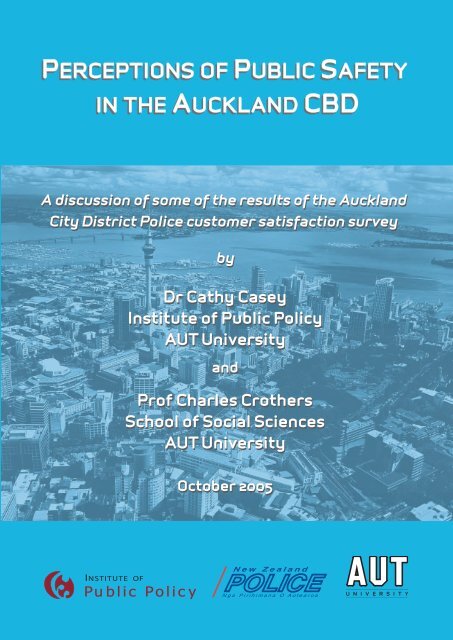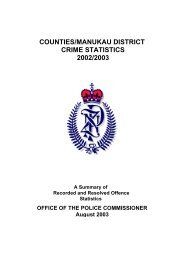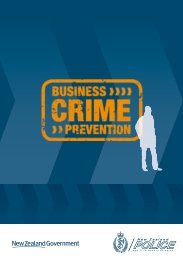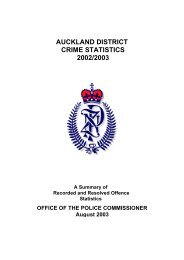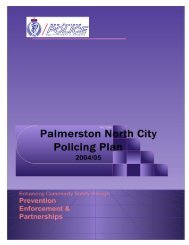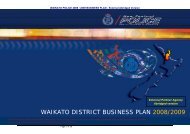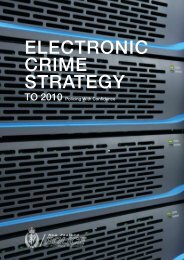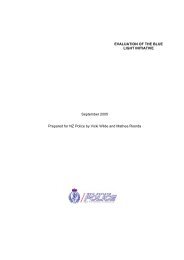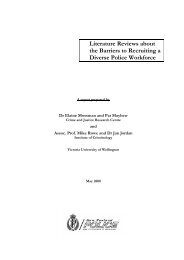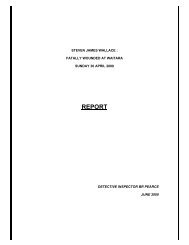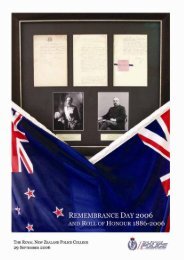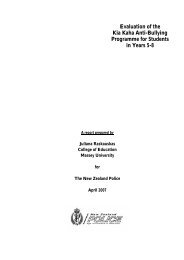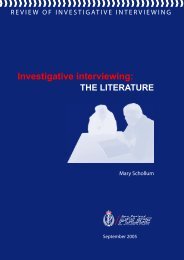Perceptions of Public Safety in the Auckland CBD - New Zealand ...
Perceptions of Public Safety in the Auckland CBD - New Zealand ...
Perceptions of Public Safety in the Auckland CBD - New Zealand ...
Create successful ePaper yourself
Turn your PDF publications into a flip-book with our unique Google optimized e-Paper software.
PERCEPTIONS OF PUBLIC SAFETY IN<br />
THE AUCKLAND <strong>CBD</strong><br />
A discussion <strong>of</strong> some <strong>of</strong> <strong>the</strong> results <strong>of</strong> <strong>the</strong> <strong>Auckland</strong> City District<br />
Police customer satisfaction survey<br />
by<br />
Dr Cathy Casey<br />
Institute <strong>of</strong> <strong>Public</strong> Policy<br />
AUT University<br />
and<br />
Pr<strong>of</strong> Charles Cro<strong>the</strong>rs<br />
School <strong>of</strong> Social Sciences<br />
AUT University<br />
October 2005
Acknowledgements<br />
The authors would like to acknowledge <strong>the</strong> significant contribution made by<br />
Sarith Yorng <strong>in</strong> <strong>the</strong> cod<strong>in</strong>g <strong>of</strong> <strong>the</strong> survey and to thank Dr Rob Webb <strong>of</strong> <strong>the</strong><br />
School <strong>of</strong> Social Sciences for assist<strong>in</strong>g with <strong>the</strong> survey design. Thanks too to<br />
<strong>the</strong> staff <strong>of</strong> CAB’s International Student Centre for co-ord<strong>in</strong>at<strong>in</strong>g <strong>the</strong><br />
distribution and return <strong>of</strong> <strong>the</strong> survey to <strong>in</strong>ternational students across <strong>Auckland</strong>.<br />
F<strong>in</strong>ally, thanks to Dr Cathie Coll<strong>in</strong>son and Dr John Mitchell <strong>of</strong> <strong>Auckland</strong> City<br />
District Police for assist<strong>in</strong>g with <strong>the</strong> design <strong>of</strong> <strong>the</strong> survey and for <strong>the</strong>ir<br />
comments on <strong>the</strong> f<strong>in</strong>al report.<br />
_____________________________________________________________________<br />
- <strong>Perceptions</strong> <strong>of</strong> <strong>Safety</strong> <strong>in</strong> <strong>the</strong> <strong>Auckland</strong> <strong>CBD</strong> – A Discussion - Page 2
CONTENTS<br />
PAGE<br />
Abstract 4<br />
A: AUCKLAND <strong>CBD</strong> – SAFETY, STRATEGIES AND RESEARCH 5<br />
<strong>Auckland</strong> City <strong>CBD</strong> 5<br />
Safer <strong>Auckland</strong> City 7<br />
Children and <strong>Safety</strong> <strong>in</strong> <strong>the</strong> <strong>CBD</strong> 8<br />
<strong>Perceptions</strong> <strong>of</strong> <strong>CBD</strong> <strong>Public</strong> <strong>Safety</strong> – Research 9<br />
B: SAFETY IN THE AUCKLAND <strong>CBD</strong> – SURVEY AND NUMBERS 12<br />
Customer Satisfaction Survey 12<br />
(i) Randomised telephoned sample 13<br />
(ii) Domestic students sample 14<br />
(iii) International students sample 14<br />
Characteristics <strong>of</strong> <strong>the</strong> samples – gender 14<br />
Characteristics <strong>of</strong> <strong>the</strong> samples – ethnicity 15<br />
Characteristics <strong>of</strong> <strong>the</strong> samples – age 17<br />
Characteristics <strong>of</strong> <strong>the</strong> samples – <strong>in</strong>come 18<br />
Frequency <strong>of</strong> visits to <strong>the</strong> <strong>CBD</strong> 19<br />
Reasons for visit<strong>in</strong>g <strong>the</strong> <strong>CBD</strong> 21<br />
<strong>Perceptions</strong> <strong>of</strong> safety <strong>in</strong> <strong>the</strong> <strong>CBD</strong> 22<br />
Change <strong>in</strong> perception <strong>of</strong> <strong>CBD</strong> safety <strong>in</strong> last five years 23<br />
C: SAFETY IN THE AUCKLAND <strong>CBD</strong> – WHAT PEOPLE SAID 25<br />
Telephoned sample 25<br />
Reasons for feel<strong>in</strong>g “safe” <strong>in</strong> <strong>the</strong> <strong>CBD</strong> 25<br />
Reasons for feel<strong>in</strong>g “unsafe” <strong>in</strong> <strong>the</strong> <strong>CBD</strong> 27<br />
Domestic students sample 30<br />
Reasons for feel<strong>in</strong>g “safe” <strong>in</strong> <strong>the</strong> <strong>CBD</strong> 30<br />
Reasons for feel<strong>in</strong>g “unsafe” <strong>in</strong> <strong>the</strong> <strong>CBD</strong> 30<br />
International students sample 31<br />
Reasons for feel<strong>in</strong>g “safe” <strong>in</strong> <strong>the</strong> <strong>CBD</strong> 31<br />
Reasons for feel<strong>in</strong>g “unsafe” <strong>in</strong> <strong>the</strong> <strong>CBD</strong> 31<br />
D: SAFETY IN THE AUCKLAND <strong>CBD</strong> – DISCUSSION 32<br />
<strong>CBD</strong> usage 32<br />
Feel<strong>in</strong>g safe <strong>in</strong> <strong>the</strong> <strong>Auckland</strong> <strong>CBD</strong> 33<br />
Reasons for feel<strong>in</strong>g safe 33<br />
Increased police presence 34<br />
<strong>Safety</strong> <strong>in</strong>itiatives 34<br />
People loiter<strong>in</strong>g <strong>in</strong> <strong>the</strong> <strong>CBD</strong> 35<br />
Crime <strong>in</strong> <strong>the</strong> <strong>CBD</strong> 36<br />
Summary 37<br />
References 38<br />
Appendix 41<br />
_____________________________________________________________________<br />
- <strong>Perceptions</strong> <strong>of</strong> <strong>Safety</strong> <strong>in</strong> <strong>the</strong> <strong>Auckland</strong> <strong>CBD</strong> – A Discussion - Page 3
Abstract<br />
Earlier this year, <strong>the</strong> Institute <strong>of</strong> <strong>Public</strong> Policy at AUT University carried out a<br />
customer satisfaction survey for <strong>the</strong> <strong>Auckland</strong> City District Police. One <strong>of</strong> <strong>the</strong><br />
aims <strong>of</strong> <strong>the</strong> survey was to exam<strong>in</strong>e perceptions <strong>of</strong> public safety <strong>in</strong> <strong>the</strong><br />
<strong>Auckland</strong> city’s central bus<strong>in</strong>ess district (<strong>CBD</strong>). In particular <strong>the</strong> survey<br />
<strong>in</strong>vestigated (1) public use <strong>of</strong> <strong>the</strong> <strong>CBD</strong>; (2) people’s perceptions <strong>of</strong> public<br />
safety with<strong>in</strong> <strong>the</strong> <strong>CBD</strong>; and (3) whe<strong>the</strong>r people’s views on safety with<strong>in</strong> that<br />
area had changed over <strong>the</strong> last five years.<br />
In this article, Casey and Cro<strong>the</strong>rs firstly review <strong>the</strong> research which has been<br />
undertaken on behalf <strong>of</strong> <strong>Auckland</strong> City and which has addressed <strong>the</strong> issue <strong>of</strong><br />
public safety <strong>in</strong> <strong>the</strong> <strong>CBD</strong>. They also exam<strong>in</strong>e <strong>the</strong> strategies council has<br />
developed which may have a bear<strong>in</strong>g on <strong>the</strong> issue <strong>of</strong> <strong>CBD</strong> safety.<br />
The authors <strong>the</strong>n discuss <strong>the</strong> f<strong>in</strong>d<strong>in</strong>gs <strong>of</strong> <strong>the</strong> <strong>Auckland</strong> City District Police<br />
customer satisfaction survey 2005 which canvassed <strong>the</strong> usage and<br />
perceptions <strong>of</strong> safety <strong>in</strong> <strong>the</strong> <strong>Auckland</strong> <strong>CBD</strong> among three discrete population<br />
samples:- 820 random householders; 209 senior college students and 117<br />
<strong>in</strong>ternational tertiary students.<br />
F<strong>in</strong>ally, <strong>the</strong> authors discuss <strong>the</strong> implications <strong>of</strong> <strong>the</strong> survey results for <strong>the</strong><br />
various jo<strong>in</strong>t police/council <strong>in</strong>itiatives to improve <strong>CBD</strong> safety and make a<br />
number <strong>of</strong> suggestions for actions which might impact positively on future<br />
perceptions <strong>of</strong> safety <strong>in</strong> <strong>the</strong> <strong>Auckland</strong> <strong>CBD</strong>.<br />
_____________________________________________________________________<br />
- <strong>Perceptions</strong> <strong>of</strong> <strong>Safety</strong> <strong>in</strong> <strong>the</strong> <strong>Auckland</strong> <strong>CBD</strong> – A Discussion - Page 4
A : AUCKLAND <strong>CBD</strong> – SAFETY, STRATEGIES AND RESEARCH<br />
<strong>Auckland</strong> City <strong>CBD</strong><br />
<strong>Auckland</strong>’s <strong>CBD</strong> has evolved over nearly 200 years <strong>of</strong> European settlement.<br />
It covers an area <strong>of</strong> 433 hectares, similar to <strong>the</strong> size <strong>of</strong> Sydney’s <strong>CBD</strong> and<br />
twice <strong>the</strong> area <strong>of</strong> Well<strong>in</strong>gton’s. It is geographically def<strong>in</strong>ed by <strong>the</strong> Waitemata<br />
harbour on one side and <strong>the</strong> region’s motorway system on <strong>the</strong> o<strong>the</strong>r.<br />
<strong>Auckland</strong> City has identified that different areas <strong>of</strong> <strong>the</strong> <strong>CBD</strong> tend to be used <strong>in</strong><br />
different ways and has developed dist<strong>in</strong>ct areas (or quarters) each with its<br />
own characteristics and uses.<br />
_____________________________________________________________________<br />
- <strong>Perceptions</strong> <strong>of</strong> <strong>Safety</strong> <strong>in</strong> <strong>the</strong> <strong>Auckland</strong> <strong>CBD</strong> – A Discussion - Page 5
It is <strong>New</strong> <strong>Zealand</strong>’s pr<strong>in</strong>cipal bus<strong>in</strong>ess centre and is <strong>the</strong> primary employment,<br />
education, enterta<strong>in</strong>ment and tourism centre <strong>of</strong> <strong>the</strong> <strong>Auckland</strong> region. It is <strong>the</strong><br />
workplace for 6,500 people. In addition, 16,000 people currently live <strong>in</strong> <strong>the</strong><br />
<strong>CBD</strong>. The <strong>CBD</strong> is <strong>the</strong>refore a key element <strong>in</strong> <strong>the</strong> <strong>Auckland</strong> city economy.<br />
<strong>Auckland</strong>’s <strong>CBD</strong>: Into <strong>the</strong> Future Strategy, published <strong>in</strong> July, 2004, is a City<br />
Council plan for reshap<strong>in</strong>g and revitalis<strong>in</strong>g <strong>Auckland</strong>’s central bus<strong>in</strong>ess area.<br />
It is funded through a targeted rate which will raise $10.3 million over ten<br />
years. The plan notes that approximately 270,000 people travel <strong>in</strong>to or<br />
through <strong>the</strong> <strong>CBD</strong> daily and that 95 per cent <strong>of</strong> <strong>the</strong>m are likely to come from <strong>the</strong><br />
<strong>Auckland</strong> region. It notes that most people come <strong>in</strong>to <strong>the</strong> <strong>CBD</strong> for work (31<br />
per cent); o<strong>the</strong>rs come for recreation and leisure (31 per cent) shopp<strong>in</strong>g (21<br />
per cent) or education (9 per cent) and that <strong>the</strong>re are important differences <strong>in</strong><br />
<strong>the</strong> times different areas <strong>of</strong> <strong>the</strong> <strong>CBD</strong> are used. Activities and users can differ<br />
between day and night, with more bus<strong>in</strong>ess dur<strong>in</strong>g <strong>the</strong> day and more<br />
recreation at night.<br />
_____________________________________________________________________<br />
- <strong>Perceptions</strong> <strong>of</strong> <strong>Safety</strong> <strong>in</strong> <strong>the</strong> <strong>Auckland</strong> <strong>CBD</strong> – A Discussion - Page 6
In consult<strong>in</strong>g with stakeholders as part <strong>of</strong> <strong>the</strong> <strong>Auckland</strong>’s <strong>CBD</strong>: Into <strong>the</strong> Future<br />
Strategy, <strong>Auckland</strong> City found that safety was a significant issue. Many<br />
stakeholders commented that <strong>the</strong> <strong>in</strong>ner city felt "unsafe" <strong>in</strong> many aspects and<br />
that <strong>the</strong> council needed a comprehensive strategy to address perceived<br />
shortfalls. <strong>Auckland</strong> City identified that need with<strong>in</strong> <strong>the</strong> strategy:<br />
“People are entitled to feel safe when us<strong>in</strong>g <strong>Auckland</strong>’s <strong>CBD</strong>.<br />
Therefore, <strong>the</strong> <strong>CBD</strong> will be planned, designed and ma<strong>in</strong>ta<strong>in</strong>ed <strong>in</strong><br />
ways that enhance personal safety.” (p.21)<br />
Responsibility to develop a strategy to respond to <strong>the</strong>se safety concerns was<br />
delegated to Safer <strong>Auckland</strong> City, <strong>Auckland</strong>’s Safer Community Council.<br />
Safer <strong>Auckland</strong> City<br />
Safer <strong>Auckland</strong> City (SAC) was established <strong>in</strong> 1995 to deal with crime<br />
prevention and community safety <strong>in</strong> <strong>Auckland</strong> city. SAC has partnerships with<br />
four major stakeholders: <strong>Auckland</strong> City Council, Ngati Whatua O Orakei, <strong>the</strong><br />
<strong>Auckland</strong> City District Police and <strong>the</strong> Government’s Crime Prevention Unit.<br />
The emphasis <strong>of</strong> SAC is on community safety and crime reduction. By coord<strong>in</strong>at<strong>in</strong>g<br />
<strong>the</strong> views <strong>of</strong> its four stakeholders, it aims for an <strong>in</strong>tegrated<br />
approach to address<strong>in</strong>g <strong>Auckland</strong> city’s safety issues. The partnership<br />
agreement supports <strong>the</strong> <strong>Auckland</strong> City District Police <strong>in</strong> <strong>the</strong>ir role <strong>in</strong> <strong>the</strong><br />
reduction <strong>in</strong> crime with<strong>in</strong> <strong>the</strong> <strong>Auckland</strong> City <strong>CBD</strong>.<br />
In response, to <strong>the</strong> concerns <strong>of</strong> <strong>CBD</strong> stakeholders, <strong>in</strong> 2003, SAC developed<br />
an Inner City <strong>Safety</strong> Strategy. This identifies <strong>the</strong> key safety issues and<br />
<strong>in</strong>itiatives for <strong>Auckland</strong> City Council <strong>in</strong> <strong>the</strong> <strong>CBD</strong>. Its aim is:<br />
“To make <strong>Auckland</strong> City's <strong>CBD</strong> safe for workers, residents and<br />
visitors, and contribut<strong>in</strong>g to <strong>the</strong> <strong>CBD</strong> becom<strong>in</strong>g a place that is<br />
liveable, vibrant and safe.” (p.2)<br />
_____________________________________________________________________<br />
- <strong>Perceptions</strong> <strong>of</strong> <strong>Safety</strong> <strong>in</strong> <strong>the</strong> <strong>Auckland</strong> <strong>CBD</strong> – A Discussion - Page 7
Its objectives are:<br />
To promote responsible and safe alcohol use and management<br />
To create a safe physical environment<br />
To work <strong>in</strong> partnership with Maori and Pacific peoples to address <strong>the</strong><br />
issues <strong>of</strong> Maori and Pacific Island crime and victimisation<br />
To address <strong>the</strong> crime and safety issues relat<strong>in</strong>g to youth<br />
To <strong>in</strong>crease <strong>the</strong> perceptions <strong>of</strong> safety for residents, workers and visitors<br />
The strategy acknowledges <strong>the</strong> contribution made to <strong>in</strong>ner city safety by a<br />
variety <strong>of</strong> organisations <strong>in</strong>clud<strong>in</strong>g <strong>Auckland</strong> City Council, Safer <strong>Auckland</strong> City,<br />
<strong>Auckland</strong> City District Police, <strong>the</strong> Maori Wardens and Ngati Whatua O Orakei.<br />
The strategy outl<strong>in</strong>es 15 projects aimed at promot<strong>in</strong>g <strong>CBD</strong> safety <strong>in</strong>clud<strong>in</strong>g:<br />
<strong>Auckland</strong> City Liquor Ban; <strong>Auckland</strong> City Gambl<strong>in</strong>g Accord; Crime Prevention<br />
Through Environmental Design (CPTED); CCTV Upgrade and Evaluation;<br />
Maori Wardens Project; Ambassador Programme etc. (See Appendix One for<br />
<strong>the</strong> full list and a description <strong>of</strong> each project). S<strong>in</strong>ce <strong>Auckland</strong> City approved<br />
<strong>the</strong> Inner <strong>Safety</strong> Strategy all 15 <strong>in</strong>itiatives have been implemented.<br />
Children and <strong>Safety</strong> <strong>in</strong> <strong>the</strong> <strong>CBD</strong><br />
Dur<strong>in</strong>g 2004, <strong>Auckland</strong> City consulted with over 600 children <strong>in</strong> develop<strong>in</strong>g<br />
Grow<strong>in</strong>g up toge<strong>the</strong>r, its draft child and family policy. Among <strong>the</strong> 28 questions<br />
<strong>in</strong> <strong>the</strong> children’s questionnaire, <strong>the</strong>re were three questions about safety <strong>in</strong> <strong>the</strong><br />
<strong>CBD</strong>:<br />
Is <strong>the</strong> central city a safe place for you to go?<br />
Why?<br />
What would make it safer?<br />
_____________________________________________________________________<br />
- <strong>Perceptions</strong> <strong>of</strong> <strong>Safety</strong> <strong>in</strong> <strong>the</strong> <strong>Auckland</strong> <strong>CBD</strong> – A Discussion - Page 8
Most <strong>of</strong> <strong>the</strong> 600 children who participated (67 per cent) thought that <strong>the</strong><br />
central city was a safe place to go. The children had clear ideas about what<br />
would make it safer (although <strong>the</strong> report’s author recognises that it may have<br />
been a slightly lead<strong>in</strong>g question). These <strong>in</strong>cluded:<br />
If it was cleaner<br />
If <strong>the</strong>re was less traffic<br />
If <strong>the</strong>re was more police<br />
Less crime<br />
More traffic lights<br />
No alcohol<br />
Less crazy, and bad people<br />
Less people<br />
One young respondent had a very clear idea about what should be done:<br />
“I don’t go <strong>in</strong>to <strong>the</strong> central city a lot because I might get lost. Maybe a sign<br />
could be made with “lost” on it and <strong>the</strong>n children who were lost could go<br />
<strong>the</strong>re.”<br />
<strong>Perceptions</strong> <strong>of</strong> <strong>CBD</strong> <strong>Public</strong> <strong>Safety</strong> – Research<br />
In 2002, <strong>Auckland</strong> City carried out a survey <strong>of</strong> perceptions <strong>of</strong> residents,<br />
workers and visitors to <strong>the</strong> central city <strong>in</strong> relation to personal safety. 1<br />
Response rates were low: <strong>of</strong> <strong>the</strong> 629 questionnaires returned, <strong>the</strong> bus<strong>in</strong>ess<br />
response rate was 33 per cent and <strong>the</strong> residential response rate 18 per cent.<br />
Face to face street <strong>in</strong>terviews dur<strong>in</strong>g <strong>the</strong> day made up 52 per cent <strong>of</strong> <strong>the</strong> total<br />
responses.<br />
Approximately 50 per cent <strong>of</strong> respondents felt that it was not safe to be alone<br />
<strong>in</strong> <strong>the</strong> city after dark, with women feel<strong>in</strong>g more unsafe than men at night (64<br />
per cent compared with 42 per cent).<br />
The majority <strong>of</strong> respondents thought<br />
<strong>of</strong>fensive and threaten<strong>in</strong>g behaviour and isolated back streets make <strong>the</strong> city<br />
1 <strong>Auckland</strong> City; Behaviour and Attitudes and Perception s o f Residents, Workers and Visitors to <strong>the</strong><br />
Central City, Report prepared by Central Area Plann<strong>in</strong>g – City Plann<strong>in</strong>g, February 2003.<br />
_____________________________________________________________________<br />
- <strong>Perceptions</strong> <strong>of</strong> <strong>Safety</strong> <strong>in</strong> <strong>the</strong> <strong>Auckland</strong> <strong>CBD</strong> – A Discussion - Page 9
an unsafe place at night. O<strong>the</strong>r concerns at night <strong>in</strong>cluded poor street light<strong>in</strong>g<br />
and lack <strong>of</strong> police/surveillance. When asked for suggestions for improv<strong>in</strong>g<br />
safety <strong>in</strong> <strong>the</strong> city centre, respondents identified that <strong>the</strong> most important<br />
improvement would be to provide more police; second, more light<strong>in</strong>g and<br />
third, more closed circuit television cameras.<br />
Two more recent research reports commissioned by <strong>Auckland</strong> City have<br />
made comment on <strong>the</strong> perceptions <strong>of</strong> safety <strong>in</strong> <strong>the</strong> <strong>CBD</strong> from <strong>the</strong> perspective<br />
<strong>of</strong> <strong>in</strong>ternational students <strong>in</strong> one case and Asian people <strong>in</strong> ano<strong>the</strong>r.<br />
In December 2003, <strong>Auckland</strong> consultants Infometrics produced “International<br />
Students – Their Impact on <strong>Auckland</strong> City”. Accord<strong>in</strong>g to <strong>the</strong> authors its<br />
objective was to:<br />
“… ascerta<strong>in</strong> <strong>the</strong> contribution that export education makes to <strong>the</strong><br />
<strong>Auckland</strong> economy, discuss <strong>the</strong> prospects for <strong>the</strong> <strong>in</strong>dustry, identify<br />
<strong>the</strong> risks to <strong>the</strong> <strong>in</strong>dustry and how <strong>the</strong>y are be<strong>in</strong>g managed, and<br />
consider <strong>the</strong> <strong>in</strong>frastructural needs <strong>of</strong> <strong>the</strong> <strong>in</strong>dustry – transport,<br />
accommodation and so forth.” (p.1)<br />
The authors collected <strong>the</strong> <strong>in</strong>formation by analys<strong>in</strong>g available quantitative<br />
<strong>in</strong>formation e.g. M<strong>in</strong>istry <strong>of</strong> Education and Statistics NZ and <strong>in</strong>terview<strong>in</strong>g<br />
<strong>in</strong>dustry players.<br />
“The report notes that safety is a crucial component <strong>of</strong> <strong>the</strong> <strong>New</strong><br />
<strong>Zealand</strong> educational experience and a section deals with Social and<br />
Security issues. It notes that cluster<strong>in</strong>g <strong>of</strong> <strong>in</strong>ternational students <strong>in</strong><br />
<strong>the</strong> <strong>CBD</strong> <strong>in</strong>creases <strong>the</strong> probability <strong>of</strong> students be<strong>in</strong>g exposed to<br />
<strong>in</strong>timidation and possibly extortion and that certa<strong>in</strong> <strong>CBD</strong> venues are<br />
“well known to <strong>the</strong> <strong>Auckland</strong> Police as ‘hot spots’.” (p.32)<br />
The report also notes that <strong>in</strong>ternational students can arrive with preconceived<br />
ideas about public safety <strong>in</strong> <strong>the</strong> <strong>Auckland</strong> <strong>CBD</strong> and <strong>the</strong> role <strong>of</strong> <strong>the</strong> police,<br />
which may impact on <strong>the</strong>ir experience <strong>in</strong> <strong>Auckland</strong>:<br />
_____________________________________________________________________<br />
- <strong>Perceptions</strong> <strong>of</strong> <strong>Safety</strong> <strong>in</strong> <strong>the</strong> <strong>Auckland</strong> <strong>CBD</strong> – A Discussion - Page 10
“To some extent, students come to <strong>New</strong> <strong>Zealand</strong> <strong>in</strong> <strong>the</strong> expectation<br />
that it is a safe place and so are less wary than <strong>the</strong>y might be <strong>in</strong> <strong>the</strong>ir<br />
home country. Thus <strong>the</strong>y are more likely to be victims <strong>of</strong> crime<br />
which, toge<strong>the</strong>r with a distrust <strong>of</strong> <strong>the</strong> police among certa<strong>in</strong> ethnic<br />
groups, raises both <strong>the</strong> level <strong>of</strong> crime and <strong>the</strong> difficulty <strong>of</strong> deal<strong>in</strong>g with<br />
it … The police budget has not kept pace with <strong>the</strong> rapid growth <strong>in</strong> <strong>the</strong><br />
number <strong>of</strong> fee-pay<strong>in</strong>g students.” (p.32)<br />
A recent research project commissioned by <strong>Auckland</strong> City reviewed <strong>the</strong><br />
literature relat<strong>in</strong>g to Asian people <strong>in</strong> <strong>the</strong> <strong>Auckland</strong> <strong>CBD</strong>. Megan Fidler<br />
Research (February 2005) exam<strong>in</strong>ed perceptions <strong>of</strong> safety identified <strong>in</strong> <strong>the</strong><br />
literature not<strong>in</strong>g that <strong>the</strong> <strong>CBD</strong> is currently perceived to be unsafe by Asian<br />
people and that public safety and monitor<strong>in</strong>g <strong>of</strong> crime is a major concern to<br />
<strong>the</strong> Asian community.<br />
“The perceived lack <strong>of</strong> safety was surpris<strong>in</strong>g to people who have<br />
moved to <strong>Auckland</strong> recently, as <strong>the</strong>y formerly perceived <strong>Auckland</strong><br />
and <strong>New</strong> <strong>Zealand</strong> generally, to be safe. Many <strong>of</strong> <strong>the</strong> suggestions<br />
about how to make <strong>the</strong> <strong>CBD</strong> safer focused on prevention and<br />
<strong>in</strong>cluded such th<strong>in</strong>gs as a greater police presence, light<strong>in</strong>g and safe<br />
public transport. It was suggested that <strong>in</strong>creas<strong>in</strong>g <strong>the</strong> understand<strong>in</strong>g<br />
between police and different Asian communities would create<br />
dialogue between communities and <strong>the</strong> police and so make <strong>the</strong> <strong>CBD</strong><br />
a safer place for Asian people.” (p. 6)<br />
Megan Fidler Research quotes from Mandela Research’s 2003 work for<br />
<strong>Auckland</strong> City which noted that Asian people are shocked by <strong>the</strong> lack <strong>of</strong> size<br />
and power <strong>of</strong> <strong>the</strong> police and that <strong>the</strong>y are surprised by police attitudes<br />
regard<strong>in</strong>g burglary and <strong>the</strong>ft compla<strong>in</strong>ts.<br />
“They are told to claim on <strong>the</strong>ir <strong>in</strong>surance, told to jo<strong>in</strong> <strong>the</strong> local<br />
neighbourhood watch group, and one compla<strong>in</strong>ant was allegedly told<br />
to stay at home. This perceived lack <strong>of</strong> action erodes <strong>the</strong>ir faith <strong>in</strong> <strong>the</strong><br />
police to catch crim<strong>in</strong>als.” (p.22)<br />
_____________________________________________________________________<br />
- <strong>Perceptions</strong> <strong>of</strong> <strong>Safety</strong> <strong>in</strong> <strong>the</strong> <strong>Auckland</strong> <strong>CBD</strong> – A Discussion - Page 11
Mandela Research also noted a reluctance by Asian people to report violent<br />
crime because <strong>the</strong>y do not believe <strong>the</strong> police will deal with <strong>the</strong> case promptly<br />
thus allow<strong>in</strong>g <strong>the</strong> perpetrators and witnesses to leave <strong>New</strong> <strong>Zealand</strong>. They<br />
also found that Asian people may have limited trust <strong>in</strong> <strong>the</strong> <strong>Auckland</strong> City<br />
District Police because <strong>of</strong> corruption <strong>in</strong> <strong>the</strong>ir own country’s police.<br />
F<strong>in</strong>ally Mandela Research noted that Asians identified <strong>the</strong> <strong>Auckland</strong> Sky City<br />
Cas<strong>in</strong>o as <strong>the</strong> focus for some crim<strong>in</strong>al <strong>of</strong>fend<strong>in</strong>g at that time because:<br />
“It is one <strong>of</strong> <strong>the</strong> only socialis<strong>in</strong>g venues open late <strong>in</strong>to <strong>the</strong> night.”<br />
(p.22)<br />
A number <strong>of</strong> <strong>the</strong> suggestions made to Mandela Research for improv<strong>in</strong>g<br />
perceptions <strong>of</strong> safety <strong>in</strong> <strong>the</strong> <strong>CBD</strong> for Asian people specifically related to<br />
polic<strong>in</strong>g:<br />
Improved police/community education programmes<br />
Increase <strong>in</strong> <strong>the</strong> number <strong>of</strong> police ethnic community liaison <strong>of</strong>ficers<br />
More communication about <strong>the</strong> police role<br />
Address<strong>in</strong>g racism (real or perceived) with<strong>in</strong> <strong>the</strong> police<br />
More user-friendly police communications strategy.<br />
B: SAFETY IN THE AUCKLAND <strong>CBD</strong> – SURVEY AND NUMBERS<br />
Customer Satisfaction Survey<br />
<strong>Auckland</strong> City District Police requested Dr Cathy Casey <strong>of</strong> <strong>the</strong> Institute <strong>of</strong><br />
<strong>Public</strong> Policy at AUT University to design and adm<strong>in</strong>ister a customer<br />
satisfaction survey as part <strong>of</strong> IPP’s commitment under <strong>the</strong>ir Memorandum <strong>of</strong><br />
Understand<strong>in</strong>g.<br />
_____________________________________________________________________<br />
- <strong>Perceptions</strong> <strong>of</strong> <strong>Safety</strong> <strong>in</strong> <strong>the</strong> <strong>Auckland</strong> <strong>CBD</strong> – A Discussion - Page 12
A number <strong>of</strong> meet<strong>in</strong>gs were held with senior staff <strong>of</strong> <strong>Auckland</strong> City District<br />
Police to discuss <strong>the</strong> survey’s content. It was decided that <strong>the</strong> questions<br />
would focus on three areas:<br />
1. Satisfaction with service received from <strong>Auckland</strong> City District Police<br />
2. <strong>Perceptions</strong> <strong>of</strong> NZ Police generally<br />
3. Usage <strong>of</strong>, and perceptions <strong>of</strong> personal safety <strong>in</strong>, <strong>the</strong> <strong>Auckland</strong> <strong>CBD</strong><br />
The AUT University Ethics Committee approved <strong>the</strong> methodology for <strong>the</strong><br />
Au ckland City District Police Customer Satisfaction Survey at its meet<strong>in</strong>g <strong>in</strong><br />
January 2005 and <strong>the</strong> survey was <strong>the</strong>n trialled and <strong>the</strong> questions ref<strong>in</strong>ed.<br />
It was decided that <strong>the</strong> survey would be adm<strong>in</strong>istered between February and<br />
March 2005 and <strong>the</strong> views <strong>of</strong> three separate populations would be canvassed:<br />
(i) A random sample <strong>of</strong> households across <strong>Auckland</strong><br />
(ii) A sample <strong>of</strong> students aged 16-18 years from an <strong>in</strong>ner city college<br />
(iii) A sample <strong>of</strong> <strong>in</strong>ternational students study<strong>in</strong>g at tertiary level<br />
(i) Randomised telephoned sample<br />
2,000 households with<strong>in</strong> <strong>the</strong> <strong>Auckland</strong> City District Police area were<br />
canvassed by telephone over <strong>the</strong> period 1 st to <strong>the</strong> 10 th <strong>of</strong> February 2005 us<strong>in</strong>g<br />
a team <strong>of</strong> six student canvassers, tra<strong>in</strong>ed and supervised by Dr Casey. The<br />
students used a telephone bank set up at <strong>the</strong> Institute <strong>of</strong> <strong>Public</strong> Policy.<br />
Telecom supplied numbers chosen at random from across <strong>the</strong> <strong>Auckland</strong> City<br />
District Police service area. 2 Calls were made between 5.30pm and 9.30pm<br />
Monday to Friday and noon-5pm on Saturdays and Sundays. 820 surveys<br />
were completed (41 per cent). A prize <strong>of</strong> a $150 d<strong>in</strong>ner at <strong>the</strong> Orbit<br />
Restaurant was <strong>of</strong>fered to every person who completed <strong>the</strong> survey and a<br />
w<strong>in</strong>ner was drawn at random. 3<br />
2 Telephone numbers for Waiheke Island were mistakenly not supplied by Telecom<br />
3 457 respondents (56 per cent) took part <strong>in</strong> <strong>the</strong> draw.<br />
_____________________________________________________________________<br />
- <strong>Perceptions</strong> <strong>of</strong> <strong>Safety</strong> <strong>in</strong> <strong>the</strong> <strong>Auckland</strong> <strong>CBD</strong> – A Discussion - Page 13
(ii) Domestic students sample<br />
The survey was adm<strong>in</strong>istered to senior co-educational school students aged<br />
16-18 years at a city college between 21st and 25th February 2005. 209<br />
students returned completed surveys.<br />
(iii) International students sample<br />
With <strong>the</strong> help <strong>of</strong> <strong>the</strong> CAB International Students Centre, 117 <strong>in</strong>ternational<br />
students filled <strong>in</strong> <strong>the</strong> survey with assistance from <strong>the</strong>ir ESL tutors between 4th<br />
and 21st March 2005. The students who completed <strong>the</strong> survey came from all<br />
over <strong>the</strong> <strong>Auckland</strong> region (i.e. beyond <strong>the</strong> <strong>Auckland</strong> City boundary) <strong>the</strong>refore<br />
comments made about service provision cannot be deemed to be specifically<br />
about <strong>Auckland</strong> City District Police.<br />
Characteristics <strong>of</strong> <strong>the</strong> samples – gender<br />
There were more females than males <strong>in</strong> <strong>the</strong> randomised telephoned sample<br />
(59 per cent female, 40 per cent male) and <strong>the</strong> domestic student sample (52<br />
per cent female, 43 per cent male). In <strong>the</strong> <strong>in</strong>ternational students’ sample,<br />
<strong>the</strong>re were more males (53 per cent) than females (40 per cent).<br />
In 2001, <strong>the</strong>re were 177,999 men (48 per cent) usually resident <strong>in</strong> <strong>the</strong> city <strong>of</strong><br />
<strong>Auckland</strong> and 189, 735 women (52 per cent). Accord<strong>in</strong>g to Our People, Our<br />
City gender <strong>in</strong> <strong>Auckland</strong> city is relatively even through all age groups. From<br />
<strong>the</strong> age <strong>of</strong> 70, women start to outnumber men.<br />
Table One: Characteristics <strong>of</strong> samples – gender<br />
Telephoned<br />
sample<br />
Domestic<br />
students sample<br />
International<br />
students sample<br />
Males 330 (40%) 90 (43%) 62 (53%)<br />
Females 486 (59%) 108 (52%) 47 (40%)<br />
Miss<strong>in</strong>g 4 (1%) 11(5%) 8 (7%)<br />
TOTAL 820 209 117<br />
_____________________________________________________________________<br />
- <strong>Perceptions</strong> <strong>of</strong> <strong>Safety</strong> <strong>in</strong> <strong>the</strong> <strong>Auckland</strong> <strong>CBD</strong> – A Discussion - Page 14
Figure One: Characteristics <strong>of</strong> samples – gender<br />
Gender - comparison<br />
70<br />
60<br />
50<br />
40<br />
30<br />
40<br />
59<br />
43<br />
52<br />
53<br />
40<br />
Male<br />
Female<br />
20<br />
10<br />
0<br />
General Survey<br />
Domestic Students<br />
International Students<br />
Characteristics <strong>of</strong> samples – ethnicity<br />
There were more self-identified NZ European <strong>in</strong> <strong>the</strong> randomised telephoned<br />
sample (68 per cent) than <strong>in</strong> <strong>the</strong> domestic student sample (32 per cent). Asian<br />
people were <strong>the</strong> majority <strong>in</strong> <strong>the</strong> <strong>in</strong>ternational student sample (72 per cent) with<br />
Asians <strong>in</strong> <strong>the</strong> domestic student sample at 21.5 per cent and 13 per cent <strong>of</strong> <strong>the</strong><br />
randomised telephoned sample.<br />
People <strong>of</strong> Pasifika descent made up 10.5 per cent <strong>of</strong> <strong>the</strong> domestic student<br />
sample and 5 per cent <strong>of</strong> <strong>the</strong> randomised telephoned sample. One per cent<br />
<strong>of</strong> <strong>the</strong> <strong>in</strong>ternational students claimed a Pasifika background. People <strong>of</strong> Maori<br />
descent were about <strong>the</strong> same <strong>in</strong> <strong>the</strong> domestic student sample (5 per cent)<br />
than <strong>the</strong> randomised telephoned sample (4 per cent).<br />
In 2001, <strong>the</strong>re were people from 181 different ethnic groups liv<strong>in</strong>g <strong>in</strong> <strong>Auckland</strong><br />
city, mak<strong>in</strong>g it <strong>the</strong> most ethnically diverse city <strong>in</strong> <strong>New</strong> <strong>Zealand</strong>. In 2001, NZ<br />
_____________________________________________________________________<br />
- <strong>Perceptions</strong> <strong>of</strong> <strong>Safety</strong> <strong>in</strong> <strong>the</strong> <strong>Auckland</strong> <strong>CBD</strong> – A Discussion - Page 15
Europeans made up 66 per cent <strong>of</strong> <strong>the</strong> population <strong>of</strong> <strong>Auckland</strong> city, down from<br />
73 per cent <strong>in</strong> 1991. Maori and Pacific Islands populations rema<strong>in</strong>ed fairly<br />
static, decreas<strong>in</strong>g 1 per cent between 1991 and 2001 to make up 8 per cent<br />
and 14 per cent <strong>of</strong> <strong>the</strong> population respectively. 4<br />
In <strong>Auckland</strong> city, <strong>the</strong> Asian population experienced <strong>the</strong> greatest share <strong>of</strong><br />
growth, up from 25,000 <strong>in</strong> 1991 to 63,000 (18 per cent) <strong>in</strong> 2001 5 . This growth<br />
is reflected <strong>in</strong> <strong>Auckland</strong>’s fastest-grow<strong>in</strong>g Ch<strong>in</strong>ese population, which is now<br />
equivalent to <strong>the</strong> Maori population at 8 per cent.<br />
Table Two: Characteristics <strong>of</strong> samples – ethnicity<br />
Domestic International<br />
Telephoned<br />
students students<br />
sample<br />
sample sample<br />
NZ European 558 (68%) 67 (32%) 9 (8%)<br />
Asian 109 (13%) 45 (21.5%) 84 (72%)<br />
Pasifika 40 (5%) 22 (10.5%) 1 (1%)<br />
Maori 35 (4%) 11 (5%) 0<br />
O<strong>the</strong>r 72 (9%) 51 (24%) 18 (15%)<br />
Miss<strong>in</strong>g 6 (1%) 15 (7%) 5 (4%)<br />
TOTAL 820 209 117<br />
4 <strong>Auckland</strong> City; Our People, Our City<br />
5 ibid<br />
_____________________________________________________________________<br />
- <strong>Perceptions</strong> <strong>of</strong> <strong>Safety</strong> <strong>in</strong> <strong>the</strong> <strong>Auckland</strong> <strong>CBD</strong> – A Discussion - Page 16
Figure Two: Characteristics <strong>of</strong> samples - ethnicity<br />
Ethnic Background - comparison<br />
80<br />
70<br />
60<br />
50<br />
40<br />
30<br />
20<br />
10<br />
0<br />
72<br />
68<br />
32<br />
21.5<br />
24<br />
13<br />
15<br />
9<br />
10.5<br />
8<br />
5 4 5<br />
1 0<br />
General Survey Domestic Students International Students<br />
NZ European<br />
Asian<br />
Pasifika<br />
Maori<br />
O<strong>the</strong>r<br />
Characteristics <strong>of</strong> samples – age<br />
The age pr<strong>of</strong>ile <strong>of</strong> <strong>the</strong> telephoned survey was spread across all age ranges, <strong>in</strong><br />
a similar pattern to <strong>the</strong> <strong>Auckland</strong> population as a whole.<br />
<strong>Auckland</strong> city’s population is relat ively young, with a median age <strong>of</strong> 33 years<br />
compared with 35 for <strong>the</strong> <strong>New</strong> <strong>Zealand</strong> population as a whole. <strong>Auckland</strong> city<br />
has experienced a decl<strong>in</strong>e <strong>in</strong> <strong>the</strong> number <strong>of</strong> people who are over 65, despite<br />
<strong>in</strong>creas<strong>in</strong>g nationwide. This decl<strong>in</strong>e <strong>in</strong> <strong>the</strong> older population is balanced by<br />
<strong>in</strong>creases <strong>in</strong> <strong>the</strong> number <strong>of</strong> people aged between 45 and 64 years, which has<br />
grown steadily s<strong>in</strong>ce 1991. In 2001, 10% <strong>of</strong> <strong>the</strong> population <strong>of</strong> <strong>Auckland</strong> city<br />
was over 65. 6<br />
The questionnaire for <strong>the</strong> domestic students did not require respondents to<br />
state age s<strong>in</strong>ce <strong>the</strong>y were all between 16 and 18 years. It was this<br />
questionnaire that was used for <strong>the</strong> <strong>in</strong>ternational students, so age data was<br />
not ga<strong>the</strong>red.<br />
6 <strong>Auckland</strong> City. Our People, Our City<br />
_____________________________________________________________________<br />
- <strong>Perceptions</strong> <strong>of</strong> <strong>Safety</strong> <strong>in</strong> <strong>the</strong> <strong>Auckland</strong> <strong>CBD</strong> – A Discussion - Page 17
Table Three: Characteristics <strong>of</strong> samples – age<br />
Telephoned sample<br />
Under 20 44 (5.5%)<br />
20-29 149 (18%)<br />
30-39 208 (25.5%)<br />
40-49 158 (19%)<br />
50-59 105 (13%)<br />
60-69 70 (8.5%)<br />
Over 70 78 (9.5%)<br />
Miss<strong>in</strong>g 8 (1%)<br />
TOTAL 820<br />
Figure Three: Age – Telephoned sample<br />
Age - Telephoned Sample<br />
30<br />
25<br />
25.5<br />
Under 20<br />
20<br />
15<br />
18<br />
19<br />
13<br />
20-29<br />
30-39<br />
40-49<br />
10<br />
5<br />
5. 5<br />
8.5<br />
9.5<br />
50-59<br />
60-69<br />
Over 70<br />
0<br />
Characteristics <strong>of</strong> samples – <strong>in</strong>come<br />
The <strong>in</strong>come distribution reported for <strong>the</strong> randomised telephoned sample was<br />
similar to <strong>the</strong> distribution <strong>of</strong> <strong>in</strong>come for <strong>Auckland</strong> city as a whole. In 2001, <strong>the</strong><br />
median <strong>in</strong>come was $22,000. 47 per cent <strong>of</strong> <strong>the</strong> population <strong>of</strong> <strong>Auckland</strong> city<br />
have an <strong>in</strong>come <strong>of</strong> $20,000 or less and 18 per cent have an <strong>in</strong>come <strong>of</strong><br />
$50,000 or more.<br />
_____________________________________________________________________<br />
- <strong>Perceptions</strong> <strong>of</strong> <strong>Safety</strong> <strong>in</strong> <strong>the</strong> <strong>Auckland</strong> <strong>CBD</strong> – A Discussion - Page 18
Table Four: Telephoned sample – <strong>in</strong>come<br />
Telephoned sample<br />
Under $20, 000<br />
194 (24%)<br />
$20,000-$39,999 166 (20%)<br />
$40,000-$59,999 125 (15%)<br />
$60,000-$79,999 67 (8%)<br />
Over $80,000 81 (10%)<br />
Miss<strong>in</strong>g 187 (23%)<br />
TOTAL 820<br />
Figure Four: Income – Telephoned Sample<br />
Income - Telephoned Sample<br />
24<br />
20<br />
15<br />
8<br />
10<br />
Under $20,000<br />
$20,000-$39,999<br />
$40,000-$59,999<br />
$60,000-$79,999<br />
Over $80,000<br />
Frequency <strong>of</strong> visits to <strong>the</strong> <strong>CBD</strong><br />
79.5 per cent <strong>of</strong> International students said <strong>the</strong>y visited <strong>the</strong> <strong>CBD</strong> on a daily<br />
basis compared with 26 per cent <strong>of</strong> <strong>the</strong> randomised telephoned sample and 5<br />
per cent <strong>of</strong> domestic students.<br />
_____________________________________________________________________<br />
- <strong>Perceptions</strong> <strong>of</strong> <strong>Safety</strong> <strong>in</strong> <strong>the</strong> <strong>Auckland</strong> <strong>CBD</strong> – A Discussion - Page 19
Domestic students tended to visit <strong>the</strong> <strong>CBD</strong> once or twice a week (42 per cent)<br />
or once or twice a month (39 per cent). Similarly, <strong>the</strong> randomised telephoned<br />
sample visited once or twice a week (19.5 per cent) or once or twice a month<br />
(26 per cent).<br />
N<strong>in</strong>e per cent <strong>of</strong> <strong>the</strong> randomised telephoned sample said <strong>the</strong>y never visit <strong>the</strong><br />
<strong>CBD</strong> and five per cent <strong>of</strong> <strong>the</strong> domestic students. All <strong>of</strong> <strong>the</strong> <strong>in</strong>ternational<br />
students said that <strong>the</strong>y visit <strong>the</strong> <strong>CBD</strong>.<br />
Table Five: Frequency <strong>of</strong> visits to <strong>the</strong> <strong>CBD</strong><br />
Telephoned Domestic International<br />
sample students sample students sample<br />
Every work<strong>in</strong>g day 212 (26%) 10 (5%) 93 (79.5%)<br />
Once or twice a week 159 (19.5%) 87 (42%) 15 (13%)<br />
Once or twice a month 208 (25%) 82 (39%) 5 (4%)<br />
Once or twice a year 164 (20%) 18 (8.5%) 2 (2%)<br />
Never 73 (9%) 11 (5%) nil<br />
Miss<strong>in</strong>g 4 (0.5%) 1 (0.5%) 2 (1.5%)<br />
TOTAL 820 209 117<br />
Figure Five: Frequency <strong>of</strong> visits to <strong>the</strong> <strong>CBD</strong><br />
<strong>CBD</strong> - Frequency <strong>of</strong> Visits<br />
90<br />
80<br />
70<br />
60<br />
50<br />
40<br />
30<br />
20<br />
10<br />
0<br />
79.5<br />
42<br />
39<br />
26 25<br />
19.5 20<br />
13<br />
9<br />
5<br />
8.5<br />
5<br />
4 2 0<br />
General Survey Domestic Students International Students<br />
Daily<br />
1/2 per wk<br />
1/2 per mth<br />
1/2 per yr<br />
never<br />
_____________________________________________________________________<br />
- <strong>Perceptions</strong> <strong>of</strong> <strong>Safety</strong> <strong>in</strong> <strong>the</strong> <strong>Auckland</strong> <strong>CBD</strong> – A Discussion - Page 20
Reasons for visit<strong>in</strong>g <strong>the</strong> <strong>CBD</strong><br />
The reasons that <strong>the</strong> telephoned sample gave for visit<strong>in</strong>g <strong>the</strong> <strong>CBD</strong> were<br />
grouped <strong>in</strong>to seven ma<strong>in</strong> head<strong>in</strong>gs: recreation/leisure/d<strong>in</strong><strong>in</strong>g (29 per cent),<br />
work/bus<strong>in</strong>ess (27 per cent) and shopp<strong>in</strong>g (22 per cent). 7 For <strong>the</strong> domestic<br />
students, recreation/leisure/d<strong>in</strong><strong>in</strong>g (46 per cent) and shopp<strong>in</strong>g (38 per cent)<br />
were <strong>the</strong> ma<strong>in</strong> attractions. The <strong>in</strong>ternational students said education was<br />
<strong>the</strong>ir ma<strong>in</strong> reason for visit<strong>in</strong>g <strong>the</strong> <strong>CBD</strong> (73 per cent) with shopp<strong>in</strong>g as <strong>the</strong> o<strong>the</strong>r<br />
attraction (13 per cent).<br />
Table Six: Reasons for visit<strong>in</strong>g <strong>the</strong> <strong>CBD</strong><br />
Telephoned<br />
sample<br />
Domestic<br />
students<br />
sample<br />
International<br />
students<br />
sample<br />
Work/Bus<strong>in</strong>ess 220 (27%) 7 (3. 5%) 7 (6%)<br />
Recreation/Leisure/d<strong>in</strong><strong>in</strong>g 238 ( 29%) 91 (46%)<br />
6 (5%)<br />
Education 49 (6%) 3 (1.5%) 85 (73%)<br />
Shopp<strong>in</strong>g 182 (22%) 76 (38%) 15 (13%)<br />
Live <strong>in</strong> <strong>CBD</strong> 8 (1%) 1 (0.5%) 2 (1%)<br />
In transit 34 (4%) 1 (0.5%) 1 (1%)<br />
Miss<strong>in</strong>g 89 (11%) 20 (10%) 1 (1%)<br />
TOTAL 820 199* 117<br />
*Some domestic students gave more than one reason for visit<strong>in</strong>g <strong>the</strong> <strong>CBD</strong>. For <strong>the</strong><br />
randomised telephoned sample and <strong>the</strong> <strong>in</strong>ternationals students, <strong>the</strong> ma<strong>in</strong> reason for visit<strong>in</strong>g<br />
was given.<br />
7<br />
These figures are similar to <strong>Auckland</strong> City’s own analysis <strong>of</strong> reasons for <strong>CBD</strong> usage (see page four <strong>of</strong><br />
this report).<br />
_____________________________________________________________________<br />
- <strong>Perceptions</strong> <strong>of</strong> <strong>Safety</strong> <strong>in</strong> <strong>the</strong> <strong>Auckland</strong> <strong>CBD</strong> – A Discussion - Page 21
Figure Six: Reasons for visit<strong>in</strong>g <strong>the</strong> <strong>CBD</strong><br />
<strong>CBD</strong> - Reasons for Visits<br />
80<br />
70<br />
60<br />
50<br />
40<br />
30<br />
20<br />
10<br />
0<br />
27 29 73<br />
22<br />
46<br />
38<br />
13<br />
6<br />
1<br />
4 3.5 1.5 0.5 0.5<br />
6 5<br />
1 1<br />
General Survey Domestic International<br />
Students Students<br />
Work/Bus<strong>in</strong>ess<br />
Rec/Leisure/D<strong>in</strong><strong>in</strong>g<br />
Education<br />
Shopp<strong>in</strong>g<br />
Live <strong>in</strong> <strong>CBD</strong><br />
In Transit<br />
<strong>Perceptions</strong> <strong>of</strong> safety <strong>in</strong> <strong>the</strong> <strong>CBD</strong><br />
The majority <strong>of</strong> respondents <strong>in</strong> each <strong>of</strong> <strong>the</strong> thre e samples felt that <strong>the</strong> <strong>CBD</strong><br />
was safe. 710 <strong>of</strong> <strong>the</strong> telephoned respondents (86.5 per cent) said <strong>the</strong>y felt<br />
that <strong>the</strong> CB D was “safe” and 110 (13.5 per cent) thought it was “ unsafe”. 111<br />
<strong>of</strong> <strong>the</strong> domestic students (53 per cent) said <strong>the</strong>y felt that <strong>the</strong> <strong>CBD</strong> was “safe”<br />
and 72 said it was “unsafe” (34.5 per c ent). 89 <strong>of</strong> <strong>the</strong> <strong>in</strong>ternational students<br />
sample (76%) said <strong>the</strong> <strong>CBD</strong> felt safe and 26 (22%) felt it was unsafe.<br />
Table Seven : <strong>Perceptions</strong> <strong>of</strong> <strong>CBD</strong> safety<br />
Telephoned<br />
sample<br />
Domestic<br />
students sample<br />
International<br />
students sample<br />
Safe 710 (86.5%) 111 (53%) 89 (76%)<br />
Unsafe 110 (13.5%) 72 (34.5%) 26 (22%)<br />
No response nil 26 (12.5%) 2 (1%)<br />
TOTAL 820 209 117<br />
_____________________________________________________________________<br />
- <strong>Perceptions</strong> <strong>of</strong> <strong>Safety</strong> <strong>in</strong> <strong>the</strong> <strong>Auckland</strong> <strong>CBD</strong> – A Discussion - Page 22
Figure Seven: <strong>Perceptions</strong> <strong>of</strong> <strong>CBD</strong> <strong>Safety</strong><br />
<strong>CBD</strong> - <strong>Perceptions</strong> <strong>of</strong> <strong>Safety</strong><br />
100<br />
90<br />
80<br />
70<br />
60<br />
50<br />
40<br />
30<br />
20<br />
10<br />
0<br />
86.5<br />
13.5<br />
53<br />
34.5<br />
General Survey Domestic Students International<br />
Students<br />
76<br />
22<br />
Safe<br />
Unsafe<br />
Respondents’ views on safety <strong>in</strong> <strong>the</strong> <strong>CBD</strong> were cross-tabulated by: frequency<br />
<strong>of</strong> visits; gender; age; <strong>in</strong>come and ethnic background.<br />
It was found that<br />
frequency <strong>of</strong> visits and gender were statistically significant 8 i.e. respondents<br />
who visit <strong>the</strong> <strong>CBD</strong> less frequently were more likely to consider <strong>the</strong> <strong>CBD</strong> to be<br />
unsafe and women were more likely than men to consider <strong>the</strong> <strong>CBD</strong> unsafe.<br />
Cross tabulations for age, <strong>in</strong>come and ethnic background <strong>of</strong> respondent were<br />
not found to be statistically significant with regard to respondents’ perceptions<br />
<strong>of</strong> <strong>CBD</strong> safety.<br />
In o<strong>the</strong>r words, people’s age, <strong>in</strong>come and ethnicity did not<br />
<strong>in</strong>fluence <strong>the</strong>ir perceptions <strong>of</strong> safety <strong>in</strong> <strong>the</strong> <strong>CBD</strong>.<br />
Change <strong>in</strong> perception <strong>of</strong> <strong>CBD</strong> safety <strong>in</strong> last five years<br />
556 peo ple <strong>in</strong> <strong>the</strong> randomised telep honed sample (68 per cent) said <strong>the</strong>ir<br />
perception <strong>of</strong> safety <strong>in</strong> <strong>the</strong> <strong>CBD</strong> had changed over <strong>the</strong> last five years. Of<br />
those, 71 per cent <strong>of</strong> t hose said it was ei<strong>the</strong>r safer or about <strong>the</strong> same and 29<br />
per cent said it was less safe.<br />
8 Frequency <strong>of</strong> visits p=0.001; Gender p=0.011<br />
_____________________________________________________________________<br />
- <strong>Perceptions</strong> <strong>of</strong> <strong>Safety</strong> <strong>in</strong> <strong>the</strong> <strong>Auckland</strong> <strong>CBD</strong> – A Discussion - Page 23
126 <strong>of</strong> <strong>the</strong> domestic students’ sample (60 per cent) gave an op<strong>in</strong>ion about <strong>the</strong><br />
change <strong>in</strong> safety level over <strong>the</strong> last five years. For 62.5 per cent it was ei<strong>the</strong>r<br />
safer or about <strong>the</strong> same as it was five years ago. For 37.5 per cent it was<br />
less safe. Given that <strong>the</strong> students were all aged 16-18 and <strong>the</strong>refore would<br />
have been 11-13 five years ago and less <strong>in</strong>dependently mobile, this<br />
<strong>in</strong>formation is <strong>of</strong> limited value.<br />
Few <strong>of</strong> <strong>the</strong> <strong>in</strong>ternational students would have been <strong>in</strong> <strong>Auckland</strong> five years ago<br />
so <strong>the</strong> question was not applicable to that group.<br />
Table Eight : <strong>Perceptions</strong> <strong>of</strong> Change <strong>in</strong> <strong>CBD</strong> <strong>Safety</strong><br />
Telephoned<br />
sample<br />
Domestic<br />
students sample<br />
Safer 115 (21%) 17 (13.5%)<br />
Less safe 161 (29%) 47 (37.5%)<br />
About <strong>the</strong> same 280 (50%) 62 (49%)<br />
Miss<strong>in</strong>g 0 0<br />
TOTAL 556 126<br />
Figure Eight : <strong>Perceptions</strong> <strong>of</strong> Change <strong>in</strong> <strong>CBD</strong> <strong>Safety</strong><br />
<strong>CBD</strong> - <strong>Perceptions</strong> <strong>of</strong> Change <strong>in</strong> <strong>Safety</strong><br />
60<br />
50<br />
50 49<br />
40<br />
30<br />
20<br />
21<br />
29<br />
13.5<br />
37.5<br />
Safer<br />
Less Safe<br />
About <strong>the</strong> same<br />
10<br />
0<br />
General Survey<br />
Domestic Students<br />
_____________________________________________________________________<br />
- <strong>Perceptions</strong> <strong>of</strong> <strong>Safety</strong> <strong>in</strong> <strong>the</strong> <strong>Auckland</strong> <strong>CBD</strong> – A Discussion - Page 24
C: SAFETY IN THE AUCKLAND <strong>CBD</strong> – WHAT PEOPLE SAID<br />
Throughout this section, it needs to be borne <strong>in</strong> m<strong>in</strong>d that <strong>the</strong> majority <strong>of</strong><br />
respondents questioned felt “safe” <strong>in</strong> <strong>the</strong> <strong>Auckland</strong> <strong>CBD</strong>:<br />
86.5 per cent <strong>of</strong> <strong>the</strong> telephoned respondents felt safe<br />
53 per cent <strong>of</strong> <strong>the</strong> domestic students felt safe<br />
76 per cent <strong>of</strong> <strong>the</strong> <strong>in</strong>ternational students felt safe<br />
It is however, worthwhile to review <strong>the</strong> reasons that people gave for feel<strong>in</strong>g<br />
safe (and unsafe) to see whe<strong>the</strong>r any <strong>of</strong> <strong>the</strong> strategies and actions taken by<br />
Aucklan d City and <strong>the</strong> <strong>Auckland</strong> City District Police have had impact on<br />
perceptions <strong>of</strong> people’s safety.<br />
Telephoned sample: reasons for feel<strong>in</strong>g “sa fe” <strong>in</strong> <strong>the</strong> <strong>CBD</strong><br />
Of <strong>the</strong> 710 people <strong>in</strong> <strong>the</strong> randomised telephoned sample who said <strong>the</strong>y felt<br />
safe, when asked “What makes you say that?” one <strong>in</strong> three did not know or<br />
could not answer. It is worthwhile analys<strong>in</strong>g <strong>the</strong> 66 per cent who did give a<br />
reason for feel<strong>in</strong>g safe, despite <strong>the</strong> fact that <strong>the</strong> majority <strong>of</strong> people found it<br />
difficult to articulate any cues <strong>in</strong> <strong>the</strong> environment that gave <strong>the</strong>m a sense <strong>of</strong><br />
safety.<br />
19.5 per cent <strong>of</strong> those who felt safe said <strong>the</strong>y it was because ei<strong>the</strong>r <strong>the</strong>y had<br />
“never had a bad experience, threat or problem <strong>the</strong>re” or else just did not feel<br />
threatened <strong>in</strong> <strong>the</strong> <strong>CBD</strong>. N<strong>in</strong>e per cent <strong>of</strong> people said it was “just a general<br />
feel<strong>in</strong>g” <strong>the</strong>y had:<br />
“I’ve never seen any trouble.” 9<br />
“I’ve never had any problems.”<br />
“I haven’t heard <strong>of</strong> anyth<strong>in</strong>g that would make me th<strong>in</strong>k it was unsafe.”<br />
9<br />
Each quoted comment is from a different respondent.<br />
_____________________________________________________________________<br />
- <strong>Perceptions</strong> <strong>of</strong> <strong>Safety</strong> <strong>in</strong> <strong>the</strong> <strong>Auckland</strong> <strong>CBD</strong> – A Discussion - Page 25
One <strong>in</strong>terest<strong>in</strong>g feature is that while 109 people said that <strong>the</strong>y felt safe <strong>in</strong> <strong>the</strong><br />
<strong>CBD</strong> dur<strong>in</strong>g <strong>the</strong> day, around half <strong>of</strong> those qualified <strong>the</strong>ir statement with a<br />
remark that at night <strong>the</strong>y felt it was less safe.<br />
“It’s safe dur<strong>in</strong>g <strong>the</strong> day, but I’m more cautious at night.”<br />
“Daytim e is safe, but at night some places are safe and some are not.”<br />
“I don’t like go<strong>in</strong>g out at night, but daytime is safe.”<br />
“It’s safe dur<strong>in</strong>g <strong>the</strong> day but unsafe at night, <strong>the</strong>re’s people hang<strong>in</strong>g around.”<br />
“It’s safe dur<strong>in</strong>g <strong>the</strong> day but unsafe at night.”<br />
Any future survey should seek specific op<strong>in</strong>ion <strong>of</strong> people on safety <strong>in</strong> <strong>the</strong> <strong>CBD</strong><br />
dur<strong>in</strong>g <strong>the</strong> day and at night.<br />
The presence <strong>of</strong> a lot <strong>of</strong> people on <strong>the</strong> street <strong>in</strong> <strong>the</strong> <strong>CBD</strong> was mentioned by 4<br />
per cent <strong>of</strong> people <strong>in</strong> <strong>the</strong> telephoned sample as mak<strong>in</strong>g <strong>the</strong>m feel safe. Three<br />
per cent specifically mentioned that <strong>the</strong> presence <strong>of</strong> police <strong>in</strong> <strong>the</strong> <strong>CBD</strong><br />
contributed to <strong>the</strong>ir feel<strong>in</strong>g that <strong>the</strong> <strong>CBD</strong> was safe:<br />
“The police are always around.”<br />
“Lots <strong>of</strong> police around.”<br />
“The police station is quite close and <strong>the</strong>y are always around. I’ve never felt<br />
unsafe.”<br />
“I’ve never felt unsafe. The police always seem to be around.”<br />
“There’s a police presence <strong>in</strong> <strong>the</strong> city <strong>of</strong>ten as well as security guards. It<br />
seems more unsafe <strong>in</strong> <strong>the</strong> suburbs.”<br />
“It’s safe dur<strong>in</strong>g <strong>the</strong> day. I know <strong>in</strong> <strong>the</strong> back <strong>of</strong> my m<strong>in</strong>d that <strong>the</strong> police are<br />
never that far away.”<br />
Two per cent <strong>of</strong> people said it was safer <strong>in</strong> <strong>the</strong> <strong>Auckland</strong> <strong>CBD</strong> compared with<br />
o<strong>the</strong>r places <strong>the</strong>y had been (London, South Africa, Fiji). For example, one<br />
commented:<br />
“Compared to o<strong>the</strong>r cities <strong>in</strong> <strong>the</strong> world, it is very safe.”<br />
_____________________________________________________________________<br />
- <strong>Perceptions</strong> <strong>of</strong> <strong>Safety</strong> <strong>in</strong> <strong>the</strong> <strong>Auckland</strong> <strong>CBD</strong> – A Discussion - Page 26
There were few mentions <strong>of</strong> <strong>the</strong> various council <strong>in</strong>itiatives which have been<br />
carried out <strong>in</strong> <strong>the</strong> <strong>CBD</strong>:<br />
Good light<strong>in</strong>g (11 mentions)<br />
Video cameras operat<strong>in</strong>g (7 mentions)<br />
Alcohol ban <strong>in</strong> place (3 mentions)<br />
Security guards around (3 mentions)<br />
Despite <strong>the</strong> fact that <strong>the</strong>y <strong>in</strong>dicated that <strong>the</strong>y felt safe, one per cent <strong>of</strong><br />
respo ndents were concerned by <strong>the</strong> number <strong>of</strong> homeless people <strong>in</strong> <strong>the</strong> <strong>CBD</strong>:<br />
“Dirty, homeless people are <strong>in</strong>timidat<strong>in</strong>g and more police are needed <strong>in</strong> <strong>the</strong><br />
area.”<br />
“I don’t go <strong>the</strong>re on a Friday or Saturday night. There’s too much dr<strong>in</strong>k<strong>in</strong>g<br />
early <strong>in</strong> <strong>the</strong> morn<strong>in</strong>g and homeless people.”<br />
“It’s safe on <strong>the</strong> ma<strong>in</strong> streets, but unsafe on side streets where <strong>the</strong> homeless<br />
people are.”<br />
“It’s unsafe at St Mat<strong>the</strong>ws Church next to <strong>the</strong> City Mission.”<br />
Telephoned Sample: reasons for feel<strong>in</strong>g “unsafe” <strong>in</strong> <strong>the</strong> <strong>CBD</strong><br />
All o f <strong>the</strong> 110 people (13 per cent <strong>of</strong> <strong>the</strong> sample) who said <strong>the</strong>y felt “unsafe” <strong>in</strong><br />
<strong>the</strong> <strong>CBD</strong> gave <strong>the</strong>ir reasons.<br />
Respondents found it hard to articulate reasons for <strong>the</strong>ir views. 42 people<br />
(38 per cent) <strong>of</strong> those who felt unsafe stated that <strong>the</strong>y simply felt unsafe at<br />
night <strong>in</strong> <strong>the</strong> <strong>CBD</strong>. 26 <strong>of</strong> those (24 per cent) qualified <strong>the</strong>ir statement:<br />
“Unsafe at night – too much crime”<br />
“Unsafe at night – not enough police around”<br />
“Unsafe at night – very unsafe for <strong>the</strong> elderly at night”<br />
“Unsafe at night – lots <strong>of</strong> crime, bad people around”<br />
_____________________________________________________________________<br />
- <strong>Perceptions</strong> <strong>of</strong> <strong>Safety</strong> <strong>in</strong> <strong>the</strong> <strong>Auckland</strong> <strong>CBD</strong> – A Discussion - Page 27
The most frequent reason cited for feel<strong>in</strong>g unsafe <strong>in</strong> <strong>the</strong> <strong>CBD</strong> mentioned by 47<br />
people (43 per cent) was that <strong>the</strong>re were people who loitered <strong>in</strong> <strong>the</strong> <strong>CBD</strong> at<br />
night. These <strong>in</strong>cluded:<br />
Bad / dodgy / creepy people loiter<strong>in</strong>g (16 mentions)<br />
Homeless people (15 mentions)<br />
Drunks and <strong>in</strong>toxicated persons (15 mentions<br />
Street kids/young people (14 mentions)<br />
Crim<strong>in</strong>als (5 mentions)<br />
Boy racers (5 mentions)<br />
Ano<strong>the</strong>r reason cited by 16 people (14.5 per cent) feel<strong>in</strong>g unsafe was <strong>the</strong>ir<br />
perception that <strong>the</strong>re was more crime <strong>in</strong> <strong>the</strong> <strong>CBD</strong>.<br />
“The <strong>CBD</strong> is <strong>the</strong> largest area <strong>of</strong> crime.”<br />
“There’s a lot <strong>of</strong> crime.”<br />
“It’s unsafe at night – too much crime.”<br />
When types <strong>of</strong> crim<strong>in</strong>al <strong>of</strong>fend<strong>in</strong>g <strong>in</strong> <strong>the</strong> <strong>CBD</strong> were identified, those mentioned<br />
most frequently as contribut<strong>in</strong>g to feel<strong>in</strong>gs that <strong>the</strong> <strong>CBD</strong> was not a safe place<br />
<strong>in</strong>cluded:<br />
Drunk and disorderly (14 mentions)<br />
Violence and fight<strong>in</strong>g (6 mentions)<br />
Theft <strong>of</strong> and from cars (5 mentions)<br />
Vandalism/graffiti (2 mentions)<br />
Just as people felt safe because <strong>the</strong>y had never had a bad experience <strong>in</strong> <strong>the</strong><br />
<strong>CBD</strong>, so too did people mention that hear<strong>in</strong>g about o<strong>the</strong>r people be<strong>in</strong>g<br />
victimised <strong>in</strong> <strong>the</strong> <strong>CBD</strong> made <strong>the</strong>m feel unsafe.<br />
“I feel threatened at night. My husband was mugged at Britomart.”<br />
“My mate got beaten up.”<br />
_____________________________________________________________________<br />
- <strong>Perceptions</strong> <strong>of</strong> <strong>Safety</strong> <strong>in</strong> <strong>the</strong> <strong>Auckland</strong> <strong>CBD</strong> – A Discussion - Page 28
“I’ve heard from o<strong>the</strong>rs about <strong>in</strong>cidents that have happened like assaults.”<br />
12 people (11 per cent) specifically mentioned that crimes reported through <strong>the</strong><br />
media had <strong>in</strong>fluenced <strong>the</strong>ir view that <strong>the</strong> <strong>CBD</strong> was not safe.<br />
“There’s lots <strong>of</strong> crime on TV etc.”<br />
“I watch crimes on TV <strong>in</strong> <strong>the</strong> city.”<br />
“There’s too much crime shown <strong>in</strong> <strong>the</strong> media.”<br />
Domestic Students Sample: Reasons for feel<strong>in</strong>g “safe” <strong>in</strong> <strong>the</strong> <strong>CBD</strong><br />
One <strong>in</strong> four <strong>of</strong> <strong>the</strong> 111 domestic students who said <strong>the</strong>y felt safe <strong>in</strong> <strong>the</strong> <strong>CBD</strong><br />
could not expla<strong>in</strong> why that was so, it was just a feel<strong>in</strong>g <strong>the</strong>y had. A fur<strong>the</strong>r 34<br />
per cent said <strong>the</strong>y felt safe because <strong>the</strong>y had never had a bad experience <strong>in</strong><br />
<strong>the</strong> <strong>CBD</strong>.<br />
Hav<strong>in</strong>g “lots <strong>of</strong> people around” was <strong>the</strong><br />
domestic students:<br />
reason given by 16 per cent <strong>of</strong> <strong>the</strong><br />
“There’s too many people around for anyth<strong>in</strong>g serious to happen.”<br />
“There will always be people around when you need help.”<br />
“There are heaps <strong>of</strong> people around and so I feel comfortable, even at night.”<br />
Seven per cent <strong>in</strong>dicated that while it felt safe dur<strong>in</strong>g <strong>the</strong> day, at night it was<br />
unsafe.<br />
Only three <strong>CBD</strong> <strong>in</strong>itiatives were identified by <strong>the</strong> domestic students:<br />
Video cameras operat<strong>in</strong>g (7 mentions)<br />
Police presence (5 mentions)<br />
Security guards around (3 mentions)<br />
“Cameras see almost anyth<strong>in</strong>g that happens and <strong>the</strong>re are so many people<br />
around, not much can happen unless you are <strong>in</strong> an alleyway or a park.”<br />
“There are many security cameras <strong>in</strong>stalled around <strong>the</strong> city.”<br />
_____________________________________________________________________<br />
- <strong>Perceptions</strong> <strong>of</strong> <strong>Safety</strong> <strong>in</strong> <strong>the</strong> <strong>Auckland</strong> <strong>CBD</strong> – A Discussion - Page 29
People loiter<strong>in</strong>g <strong>in</strong> <strong>the</strong> <strong>CBD</strong> was mentioned by 4.5 per cent <strong>of</strong> <strong>the</strong> domestic<br />
students who said <strong>the</strong>y felt safe <strong>in</strong> <strong>the</strong> <strong>CBD</strong>. Of concern were: “bad guys”,<br />
“drunk people” and “weird people”.<br />
No domestic students mentioned crime as a factor affect<strong>in</strong>g <strong>the</strong>ir feel<strong>in</strong>gs <strong>of</strong><br />
safety <strong>in</strong> <strong>the</strong> <strong>CBD</strong>.<br />
Domestic students sample: reasons for feel<strong>in</strong>g “unsafe” <strong>in</strong> <strong>the</strong> <strong>CBD</strong><br />
The most frequent reason cited by just over half (51 per cent) <strong>of</strong> <strong>the</strong> 72<br />
college students who felt unsafe <strong>in</strong> <strong>the</strong> <strong>CBD</strong> was that <strong>the</strong>re were unsavoury<br />
people who loitered <strong>in</strong> <strong>the</strong> <strong>CBD</strong>.<br />
These <strong>in</strong>cluded:<br />
Bad / dodgy / creepy people loiter<strong>in</strong>g (13 mentions)<br />
Homeless people (13 mentions)<br />
Drunks and <strong>in</strong>toxicated persons (12 mentions)<br />
Street kids/young people (10 mentions)<br />
Crim<strong>in</strong>als (4 mentions)<br />
Boy racers (3 mentions)<br />
“There are many drunk and homeless people around and I’m always scared<br />
that <strong>the</strong>y will snatch my purse.”<br />
“I’ve sometimes seen <strong>the</strong> homeless people disturb<strong>in</strong>g <strong>the</strong> surround<strong>in</strong>g<br />
people.”<br />
“Lots <strong>of</strong> drunken teenagers are <strong>the</strong>re and <strong>the</strong>y want to start fights.”<br />
Eleven per cent <strong>of</strong> <strong>the</strong> domestic students mentioned that <strong>the</strong>re were too few<br />
police on <strong>the</strong> streets and <strong>the</strong>re was concern that <strong>the</strong>y did not have <strong>the</strong><br />
resources to respond properly:<br />
“ The police don’t do <strong>the</strong>ir job properly. They only concentrate on less<br />
important th<strong>in</strong>gs. My friend got mugged and <strong>the</strong>y didn’t do anyth<strong>in</strong>g.”<br />
“There’s a lack <strong>of</strong> police presence.”<br />
“There are too many dodgy people around and not enough cops.”<br />
_____________________________________________________________________<br />
- <strong>Perceptions</strong> <strong>of</strong> <strong>Safety</strong> <strong>in</strong> <strong>the</strong> <strong>Auckland</strong> <strong>CBD</strong> – A Discussion - Page 30
“If someth<strong>in</strong>g goes wrong and I r<strong>in</strong>g <strong>the</strong> police <strong>the</strong>y might send a taxi<br />
<strong>in</strong>stead.”<br />
International students sample: reasons for feel<strong>in</strong>g “safe” <strong>in</strong> <strong>the</strong> <strong>CBD</strong><br />
Over half <strong>of</strong> <strong>the</strong> 89 <strong>in</strong>ternational students (53 per cent) who reported feel<strong>in</strong>g<br />
safe <strong>in</strong> <strong>the</strong> <strong>CBD</strong> gave reasons to expla<strong>in</strong> why <strong>the</strong>y felt that way. Twenty one<br />
per cent <strong>of</strong> <strong>the</strong>se however, could only say that it was “a feel<strong>in</strong>g” <strong>the</strong>y had or<br />
that <strong>the</strong>y “had not personally experienced any problems <strong>in</strong> <strong>the</strong> <strong>CBD</strong>” and<br />
<strong>the</strong>refore had no reason to feel unsafe.<br />
Seven per cent <strong>of</strong> <strong>the</strong> <strong>in</strong>ternational students who felt safe said that hav<strong>in</strong>g lots<br />
<strong>of</strong> people around contributed to <strong>the</strong>ir feel<strong>in</strong>gs <strong>of</strong> safety.<br />
“Heaps <strong>of</strong> people around makes me not afraid.”<br />
“There are heaps <strong>of</strong> people around so kidnappers can’t kidnap me and <strong>the</strong>re<br />
are som e Korean stores <strong>the</strong>re and I can talk to <strong>the</strong>m.”<br />
The presenc e <strong>of</strong> <strong>the</strong> police <strong>in</strong> <strong>the</strong> <strong>CBD</strong> was also highlighted by seven per cent<br />
<strong>of</strong> <strong>the</strong> <strong>in</strong>ternational students, but <strong>the</strong>y did not identify any <strong>of</strong> <strong>the</strong> o<strong>the</strong>r <strong>CBD</strong><br />
<strong>in</strong>itiatives, such as CCTV.<br />
Traffic <strong>of</strong>fend<strong>in</strong>g <strong>in</strong> <strong>the</strong> <strong>CBD</strong> was <strong>the</strong> ma<strong>in</strong> type <strong>of</strong> crime identified by <strong>the</strong><br />
<strong>in</strong>ternation al students:<br />
“There are too many cars and <strong>the</strong>y drive very fast.”<br />
“The traffic is very bad and <strong>in</strong> <strong>the</strong> even<strong>in</strong>g it is even more unsafe.”<br />
“<strong>Auckland</strong> have more car.”<br />
International students sample: reasons for feel<strong>in</strong>g “unsafe” <strong>in</strong> <strong>the</strong> <strong>CBD</strong><br />
10 <strong>of</strong> <strong>the</strong> 26 <strong>in</strong>ternational students (38 per cent) questioned after <strong>the</strong>y said <strong>the</strong><br />
<strong>CBD</strong> was unsafe said that traffic <strong>in</strong> <strong>the</strong> <strong>CBD</strong> was <strong>the</strong>ir biggest problem.<br />
“Too many cars. Their driv<strong>in</strong>g is dangerous.”<br />
“After midnight <strong>the</strong>re are some drivers that shout to people and some say<br />
very bad words.”<br />
_____________________________________________________________________<br />
- <strong>Perceptions</strong> <strong>of</strong> <strong>Safety</strong> <strong>in</strong> <strong>the</strong> <strong>Auckland</strong> <strong>CBD</strong> – A Discussion - Page 31
“After midnight, it is very dangerous and sometimes when we cross <strong>the</strong> road,<br />
<strong>the</strong> cars drive very fast – scary! There are lots <strong>of</strong> cars so <strong>the</strong>re can be lots <strong>of</strong><br />
accidents.”<br />
“People dr<strong>in</strong>k driv<strong>in</strong>g.”<br />
People loiter<strong>in</strong>g <strong>in</strong> <strong>the</strong> <strong>CBD</strong> was mentioned by seven per cent <strong>of</strong> <strong>the</strong><br />
<strong>in</strong>ternational students who felt unsafe:<br />
“Lots <strong>of</strong> energy dur<strong>in</strong>g <strong>the</strong> day but at night some people are very dangerous,<br />
more so than Korea.”<br />
“Some bad people always stay outside clubs and bars and <strong>the</strong>y always make<br />
trouble.”<br />
Police <strong>in</strong>action was mentioned by one <strong>in</strong>ternational student as a negative<br />
<strong>in</strong>fluence on his perception <strong>of</strong> <strong>CBD</strong> safety.<br />
“I caught <strong>the</strong> man who scratch my car, but <strong>the</strong> police said not enough<br />
evidence.”<br />
D: SAFETY IN THE AUCKLAND <strong>CBD</strong> – DISCUSSION<br />
<strong>CBD</strong> usage<br />
The <strong>CBD</strong> figures large <strong>in</strong> <strong>the</strong> daily life <strong>of</strong> <strong>Auckland</strong>’s <strong>in</strong>ternational students.<br />
79.5 per cent visited <strong>the</strong> <strong>CBD</strong> on a daily basis compared with 26 per cent <strong>of</strong><br />
<strong>the</strong> randomised telephoned sample and 5 per cent <strong>of</strong> domestic students <strong>in</strong> <strong>the</strong><br />
sample.<br />
42 per cent <strong>of</strong> <strong>the</strong> sample <strong>of</strong> 16-18 year olds visit <strong>the</strong> <strong>CBD</strong> once or twice a<br />
week and around one fifth <strong>of</strong> <strong>the</strong> randomised telephoned sample.<br />
Presumably <strong>the</strong> only time <strong>the</strong>se respondents are free, due to work and school<br />
commitments, is <strong>the</strong> weekend. This obviously would give any visitor on <strong>the</strong><br />
week end <strong>the</strong> impression that <strong>the</strong> <strong>CBD</strong> is a place where teenagers congregate.<br />
Future surveys should ask what days <strong>of</strong> <strong>the</strong> week people visit <strong>the</strong> <strong>CBD</strong> as well<br />
as whe<strong>the</strong>r <strong>the</strong> visit is dur<strong>in</strong>g <strong>the</strong> day or at night.<br />
_____________________________________________________________________<br />
- <strong>Perceptions</strong> <strong>of</strong> <strong>Safety</strong> <strong>in</strong> <strong>the</strong> <strong>Auckland</strong> <strong>CBD</strong> – A Discussion - Page 32
N<strong>in</strong>e per cent <strong>of</strong> <strong>the</strong> telephoned population and five per cent <strong>of</strong> <strong>the</strong> domestic<br />
students said <strong>the</strong>y never visit <strong>the</strong> <strong>CBD</strong>.<br />
Feel<strong>in</strong>g safe <strong>in</strong> <strong>the</strong> <strong>Auckland</strong> <strong>CBD</strong><br />
It is important to note once aga<strong>in</strong> at <strong>the</strong> outset <strong>of</strong> this discussion that <strong>in</strong> all<br />
three sample populations, <strong>the</strong> respondents felt safe <strong>in</strong> <strong>the</strong> <strong>Auckland</strong> <strong>CBD</strong>:<br />
86.5 per cent <strong>of</strong> <strong>the</strong> telephoned respondents felt safe<br />
53 per cent <strong>of</strong> <strong>the</strong> domestic students felt safe<br />
76 per cent <strong>of</strong> <strong>the</strong> <strong>in</strong>ternational students felt safe<br />
It is however, worthwhile to review <strong>the</strong> reasons that people gave for feel<strong>in</strong>g<br />
safe (and unsafe) to see whe<strong>the</strong>r any <strong>of</strong> <strong>the</strong> strategies and actions taken by<br />
<strong>Auckland</strong> City and <strong>the</strong> <strong>Auckland</strong> City District Police have had impact on<br />
perceptions <strong>of</strong> people’s safety.<br />
Reasons for feel<strong>in</strong>g safe<br />
It was found that men felt safer <strong>in</strong> <strong>the</strong> <strong>CBD</strong> than women and that people who<br />
visited <strong>the</strong> <strong>CBD</strong> more frequently felt safer than those who did not visit <strong>the</strong><br />
<strong>CBD</strong> regularly. If <strong>the</strong>re is a positive relationship between frequency <strong>of</strong> <strong>CBD</strong><br />
use and feel<strong>in</strong>g safe <strong>the</strong>n <strong>Auckland</strong> City might consider develop<strong>in</strong>g an events<br />
strategy for attract<strong>in</strong>g more people to <strong>the</strong> <strong>CBD</strong> – especially women.<br />
The majority <strong>of</strong> respondents <strong>in</strong> all three groups found it difficult to articulate<br />
any cues <strong>in</strong> <strong>the</strong> environment that gave <strong>the</strong>m a sense <strong>of</strong> safety. This may<br />
suggest that anecdotal evidence and media reports regard<strong>in</strong>g crime may have<br />
considerable <strong>in</strong>fluence. How many people’s views <strong>of</strong> safety <strong>in</strong> <strong>the</strong> <strong>CBD</strong><br />
would be adversely affected by headl<strong>in</strong>es report<strong>in</strong>g a negative <strong>in</strong>cident <strong>in</strong> <strong>the</strong><br />
<strong>CBD</strong>?<br />
_____________________________________________________________________<br />
- <strong>Perceptions</strong> <strong>of</strong> <strong>Safety</strong> <strong>in</strong> <strong>the</strong> <strong>Auckland</strong> <strong>CBD</strong> – A Discussion - Page 33
That teenagers had no real fear <strong>of</strong> crime with<strong>in</strong> <strong>the</strong> <strong>CBD</strong> is <strong>in</strong>terest<strong>in</strong>g and<br />
may reflect <strong>the</strong>ir lack <strong>of</strong> access to local pr<strong>in</strong>t media carry<strong>in</strong>g crime and court<br />
news or <strong>the</strong>ir sense <strong>of</strong> <strong>in</strong>vulnerability.<br />
While people across all age groups said <strong>the</strong>y felt safe <strong>in</strong> <strong>the</strong> <strong>CBD</strong> dur<strong>in</strong>g <strong>the</strong><br />
day, many respondents qualified it with concern about safety at night.<br />
Increased police presence<br />
The presence <strong>of</strong> a lot <strong>of</strong> people on <strong>the</strong> street <strong>in</strong> <strong>the</strong> <strong>CBD</strong> makes people feel<br />
more se cure, as does <strong>the</strong> physical presence <strong>of</strong> <strong>the</strong> police. International<br />
students<br />
part icularly mentioned that <strong>the</strong>y felt safe with more police around.<br />
At <strong>the</strong> same time, some respondents – particularly <strong>the</strong> domestic students –<br />
expressed concern at <strong>the</strong> lack <strong>of</strong> police <strong>in</strong> <strong>the</strong> <strong>CBD</strong> and a fear by some that<br />
<strong>the</strong> police did not have enough resources to adequately respond to callouts.<br />
<strong>Auckland</strong> City District Police may wish to exam<strong>in</strong>e <strong>in</strong>ternational research on<br />
‘reassurance polic<strong>in</strong>g’ strategies which have been found to be effective<br />
overseas. Increased use <strong>of</strong> foot patrols and Maori wardens <strong>in</strong> <strong>the</strong> <strong>CBD</strong> or<br />
regular patrol car sweeps <strong>in</strong> and around <strong>the</strong> <strong>CBD</strong> may be a quick way <strong>of</strong><br />
<strong>of</strong>fer<strong>in</strong>g <strong>the</strong> public <strong>the</strong> reassurance <strong>the</strong>y need.<br />
<strong>Safety</strong> <strong>in</strong>itiatives<br />
International students did not mention any <strong>of</strong> <strong>the</strong> 15 <strong>Auckland</strong> City <strong>in</strong>itiatives<br />
implemented under <strong>the</strong> Inner City <strong>Safety</strong> Strategy.<br />
Only two were mentioned by more than three respondents <strong>in</strong> <strong>the</strong> randomised<br />
telephoned sample and <strong>the</strong> domestic students’ sample:<br />
Improved light<strong>in</strong>g<br />
CCTV cameras.<br />
This means that <strong>Auckland</strong> City needs to better communicate <strong>in</strong>formation to<br />
<strong>the</strong> public at large about each <strong>of</strong> <strong>the</strong>ir successful safety <strong>in</strong>itiatives operat<strong>in</strong>g <strong>in</strong><br />
<strong>the</strong> <strong>CBD</strong>. This could be communicated through a regular newsletter or email.<br />
_____________________________________________________________________<br />
- <strong>Perceptions</strong> <strong>of</strong> <strong>Safety</strong> <strong>in</strong> <strong>the</strong> <strong>Auckland</strong> <strong>CBD</strong> – A Discussion - Page 34
At present <strong>the</strong>re are signs <strong>in</strong> place advis<strong>in</strong>g people <strong>of</strong> <strong>the</strong> bylaw that permits<br />
CCTV cameras, but <strong>the</strong>y are wordy and do not stand out. More <strong>in</strong>novative<br />
ways could be found to enhance exist<strong>in</strong>g signs and let visitors to <strong>the</strong> <strong>CBD</strong><br />
know that a range <strong>of</strong> <strong>in</strong>itiatives are <strong>in</strong> place e.g. signs say<strong>in</strong>g “you are on<br />
camera” or “you are enter<strong>in</strong>g an alcohol-free zone”. It could simply mean<br />
spend<strong>in</strong>g more money on better light<strong>in</strong>g <strong>of</strong> pedestrian areas around Queen<br />
Street.<br />
People loiter<strong>in</strong>g <strong>in</strong> <strong>the</strong> <strong>CBD</strong><br />
A variety <strong>of</strong> people at large <strong>in</strong> <strong>the</strong> <strong>CBD</strong> late at night was mentioned by some<br />
respondents with concern. These people – <strong>of</strong> which homeless people and<br />
<strong>in</strong>toxicated people were named groups - do pose a threat to some visitors at<br />
night <strong>in</strong> <strong>the</strong> <strong>CBD</strong>. This may not be based on any actual exchange but just a<br />
fear <strong>of</strong> someone who is at large, unknown and <strong>the</strong>refore whose behaviour<br />
and mental state is unpredictable.<br />
S<strong>in</strong>ce 2004, <strong>the</strong> <strong>Auckland</strong> City Council has been address<strong>in</strong>g <strong>the</strong> issue <strong>of</strong><br />
homelessness <strong>in</strong> <strong>Auckland</strong>, <strong>in</strong> particular people sleep<strong>in</strong>g rough <strong>in</strong> <strong>the</strong> <strong>CBD</strong>.<br />
A census taken <strong>of</strong> rough sleepers <strong>in</strong> <strong>Auckland</strong> city taken by <strong>the</strong> <strong>Auckland</strong><br />
Rough Sleepers <strong>in</strong>itiative on 5 May 2004, found 63 people sleep<strong>in</strong>g rough<br />
with<strong>in</strong> 3 kilometres <strong>of</strong> <strong>the</strong> Sky Tower. There were also 33 people <strong>in</strong> police<br />
cells or temporary shelter with<strong>in</strong> <strong>the</strong> area, br<strong>in</strong>g<strong>in</strong>g <strong>the</strong> total to 96. This<br />
census has just been retaken (May 2005) and <strong>the</strong> number <strong>of</strong> people sleep<strong>in</strong>g<br />
rough was found to be 81 with a fur<strong>the</strong>r 27 people <strong>in</strong> police custody or<br />
temporary shelter, a total <strong>of</strong> 108.<br />
Several research projects on homelessness <strong>in</strong> <strong>the</strong> <strong>CBD</strong> have been<br />
commissioned by <strong>Auckland</strong> City and have recently been reported. In June<br />
2004, No Do ubt Research produced an <strong>in</strong>itial scop<strong>in</strong>g paper The Homeless<br />
and <strong>Auckland</strong>’s <strong>CBD</strong>. The research team <strong>in</strong>terviewed n<strong>in</strong>e key <strong>in</strong>formants<br />
work<strong>in</strong>g with homeless people. Accord<strong>in</strong>g to <strong>the</strong> report, homelessness <strong>in</strong> <strong>the</strong><br />
_____________________________________________________________________<br />
- <strong>Perceptions</strong> <strong>of</strong> <strong>Safety</strong> <strong>in</strong> <strong>the</strong> <strong>Auckland</strong> <strong>CBD</strong> – A Discussion - Page 35
<strong>CBD</strong> is perceived by <strong>the</strong> <strong>in</strong>formants to be <strong>in</strong>creas<strong>in</strong>g and becom<strong>in</strong>g a more<br />
visible problem which is<br />
“… at odds with <strong>the</strong> regeneration <strong>of</strong> <strong>the</strong> <strong>CBD</strong> and its role as a magnet<br />
for leisure, shopp<strong>in</strong>g, employment and tourist activities” (p.19)<br />
A number <strong>of</strong> safety concerns <strong>in</strong> <strong>the</strong> <strong>CBD</strong> were raised by <strong>in</strong>terviewees<br />
<strong>in</strong>clud<strong>in</strong>g:<br />
A perception that begg<strong>in</strong>g has <strong>in</strong>creased <strong>in</strong> recent years<br />
That visitors to <strong>the</strong> <strong>CBD</strong> <strong>of</strong>ten perceive homeless people to be a threat<br />
That <strong>the</strong>re are concerns expressed about anti-social behaviour that<br />
may result from <strong>the</strong> consumption <strong>of</strong> alcohol or drugs<br />
The research also notes that homeless people <strong>the</strong>mselves are <strong>of</strong>ten <strong>in</strong> unsafe<br />
situations and can feel harassed by police and o<strong>the</strong>r security organisations.<br />
<strong>Auckland</strong> City is currently prepar<strong>in</strong>g a policy on homelessness and an action<br />
plan which will address <strong>the</strong>se issues.<br />
O<strong>the</strong>r undesirable elements may well be dissuaded from loiter<strong>in</strong>g through <strong>the</strong><br />
presence <strong>of</strong> police foot patrols.<br />
Crime <strong>in</strong> <strong>the</strong> <strong>CBD</strong><br />
Despite <strong>the</strong> fact that reported crime <strong>in</strong> <strong>the</strong> <strong>CBD</strong> has gone down 10 , some<br />
respondents perceived that <strong>the</strong>re was generally more crime <strong>in</strong> <strong>the</strong> <strong>CBD</strong> which<br />
may affect <strong>the</strong>ir perception <strong>of</strong> <strong>CBD</strong> safety and make <strong>the</strong>m more reluctant to<br />
visit. It was public order <strong>of</strong>fences – especially drunkenness - <strong>in</strong> <strong>the</strong> <strong>CBD</strong><br />
which were <strong>of</strong> most concern to <strong>the</strong> randomised telephoned sample and<br />
domestic students. This related <strong>in</strong> large part to <strong>the</strong> people perceived to be<br />
loiter<strong>in</strong>g with <strong>in</strong>tent <strong>in</strong> <strong>the</strong> <strong>CBD</strong>. Traffic <strong>of</strong>fences were <strong>of</strong> more concern to <strong>the</strong><br />
<strong>in</strong>ternational students.<br />
10 NZ Police Crime Statistics<br />
_____________________________________________________________________<br />
- <strong>Perceptions</strong> <strong>of</strong> <strong>Safety</strong> <strong>in</strong> <strong>the</strong> <strong>Auckland</strong> <strong>CBD</strong> – A Discussion - Page 36
If crime is down <strong>in</strong> <strong>the</strong> <strong>CBD</strong>, <strong>the</strong>re must be very public ways that this can be<br />
transmitted to <strong>the</strong> <strong>Auckland</strong> public at large and <strong>the</strong> public visit<strong>in</strong>g <strong>the</strong> <strong>CBD</strong>. It<br />
may be time for <strong>the</strong> <strong>Auckland</strong> City District Police to look at new ways <strong>of</strong><br />
communicat<strong>in</strong>g that <strong>in</strong>formation – a Queen Street shop front display? A<br />
regular newsletter or email to customers?<br />
Summary<br />
T he th ree populations surveyed perceived <strong>Auckland</strong> <strong>CBD</strong> as be<strong>in</strong>g a safe<br />
plac e. Concerns were expressed about safety at night and undesirable<br />
peop le loiter<strong>in</strong>g. These fears could be allayed by greater police presence and<br />
better light<strong>in</strong>g. There was little recognition <strong>of</strong> any <strong>CBD</strong> safety <strong>in</strong>itiatives<br />
currently operat<strong>in</strong>g which means that <strong>the</strong>se strategies have not been<br />
communicated well to ei<strong>the</strong>r <strong>the</strong> public at large or <strong>the</strong> visitors to <strong>the</strong> <strong>CBD</strong>. If<br />
views on safety are affected by crime reports <strong>in</strong> <strong>the</strong> media, <strong>the</strong> police <strong>in</strong><br />
partnership with <strong>Auckland</strong> City may need to be more proactive and personal<br />
<strong>in</strong> communicat<strong>in</strong>g good news and <strong>in</strong>formation about positive <strong>in</strong>itiatives to <strong>the</strong><br />
communities <strong>the</strong>y serve.<br />
_____________________________________________________________________<br />
- <strong>Perceptions</strong> <strong>of</strong> <strong>Safety</strong> <strong>in</strong> <strong>the</strong> <strong>Auckland</strong> <strong>CBD</strong> – A Discussion - Page 37
References:<br />
<strong>Auckland</strong> City. (November, 2003) Crime & <strong>Safety</strong>: Issues for Maori. <strong>Auckland</strong>,<br />
<strong>New</strong> <strong>Zealand</strong>.<br />
<strong>Auckland</strong> City. (November, 2003) Analysis Notes from Future <strong>Auckland</strong>; The<br />
Identification <strong>of</strong> Community Outcomes – Focus Group with Asian People.<br />
<strong>Auckland</strong>, <strong>New</strong> <strong>Zealand</strong>.: Strategic Development Group, <strong>Auckland</strong> City<br />
Council.<br />
<strong>Auckland</strong> City. (May, 2005) Grow<strong>in</strong>g up toge<strong>the</strong>r: What <strong>Auckland</strong> City is<br />
do<strong>in</strong>g for Children and Families, <strong>Auckland</strong> city’s draft child and family policy.<br />
<strong>Auckland</strong>, <strong>New</strong> <strong>Zealand</strong>.<br />
<strong>Auckland</strong> City. (January, 2003) Our People, Our City. <strong>Auckland</strong>, <strong>New</strong><br />
<strong>Zealand</strong>.<br />
<strong>Auckland</strong> City. (September, 2004) Central City Access Strategy: Gett<strong>in</strong>g to,<br />
from and around <strong>the</strong> <strong>CBD</strong>. <strong>Auckland</strong>, <strong>New</strong> <strong>Zealand</strong>.<br />
<strong>Auckland</strong> City. (June, 2004) Into <strong>the</strong> Future Action Plan 2004-2007.<br />
<strong>Auckland</strong>, <strong>New</strong> <strong>Zealand</strong>.<br />
<strong>Auckland</strong> City. (March, 2004) Into <strong>the</strong> Future Strategy. <strong>Auckland</strong>, <strong>New</strong><br />
<strong>Zealand</strong>.<br />
<strong>Auckland</strong> City. (February, 2003) Behaviour and Attitudes and <strong>Perceptions</strong> <strong>of</strong><br />
Residents, Workers and Visitors <strong>in</strong> <strong>the</strong> Central City. Report prepared by<br />
Central Area Plann<strong>in</strong>g – City Plann<strong>in</strong>g. <strong>Auckland</strong>, <strong>New</strong> <strong>Zealand</strong>.<br />
<strong>Auckland</strong> Rough Sleepers Initiative. (August 2004) <strong>Auckland</strong> Rough<br />
Sleepers Street Count Conducted 5 May, 2004. <strong>Auckland</strong>, <strong>New</strong> <strong>Zealand</strong>.<br />
_____________________________________________________________________<br />
- <strong>Perceptions</strong> <strong>of</strong> <strong>Safety</strong> <strong>in</strong> <strong>the</strong> <strong>Auckland</strong> <strong>CBD</strong> – A Discussion - Page 38
<strong>Auckland</strong> Rough Sleepers Initiative. (May, 2005) <strong>Auckland</strong> Rough Sleepers<br />
Street Count Conducted 18 May, 2005. <strong>Auckland</strong>, <strong>New</strong> <strong>Zealand</strong>.<br />
Davidson, C. ( June, 2004) The Homeless <strong>in</strong> <strong>Auckland</strong>’s <strong>CBD</strong> – A Review <strong>of</strong><br />
Issues, Trends and Options. <strong>Auckland</strong>, <strong>New</strong> <strong>Zealand</strong>.:No Doubt Research.<br />
Gia Nghi Phung. (September 2003) <strong>Auckland</strong> Asia Trail. <strong>Auckland</strong>, <strong>New</strong><br />
<strong>Zealand</strong>.<br />
Glover, D. and Associates. (May, 2005) A Plan for Homeless and<br />
Marg<strong>in</strong>alised Populations <strong>in</strong> <strong>Auckland</strong>’s Inner City. <strong>Auckland</strong> <strong>New</strong> <strong>Zealand</strong>.:<br />
Gravitas Research and Strategy Ltd.<br />
Infometrics. (December, 2003) International Students and <strong>the</strong>ir Impact on<br />
<strong>Auckland</strong> City. <strong>Auckland</strong>, <strong>New</strong> <strong>Zealand</strong>.<br />
Kudos Organisational Dynamics Ltd. (October, 2000) Asian Community<br />
Needs, Lifestyle and Interaction with <strong>Auckland</strong> City Council – With a Particular<br />
Focus on Migrant Communities. <strong>Auckland</strong>, <strong>New</strong> <strong>Zealand</strong>.<br />
Mandela Research. (2003) The Providence Report. <strong>Auckland</strong>, <strong>New</strong> <strong>Zealand</strong>.<br />
Megan Fidler Research. (February, 2005) The Ethnic Diversity Framework<br />
Project Asian Peoples <strong>in</strong> <strong>the</strong> <strong>CBD</strong>: A Literature Review. <strong>Auckland</strong>, <strong>New</strong><br />
<strong>Zealand</strong>.<br />
Safer <strong>Auckland</strong> City (2004) Inner City <strong>Safety</strong> Strategy. <strong>Auckland</strong>, <strong>New</strong><br />
<strong>Zealand</strong>.<br />
Shirley, Ian, Dupois, Ann., Tie, Warwick., Davidson, Karl., Kiro, C<strong>in</strong>dy.,<br />
Mulitalo, Tafa., & Bartley, Allen. (August, 1998) Deal<strong>in</strong>g with Crime: A Crime<br />
Pr<strong>of</strong>ile Commissioned by <strong>the</strong> <strong>Auckland</strong> City Council for Safer <strong>Auckland</strong> City,<br />
Summary Report. <strong>Auckland</strong>, <strong>New</strong> <strong>Zealand</strong>.<br />
_____________________________________________________________________<br />
- <strong>Perceptions</strong> <strong>of</strong> <strong>Safety</strong> <strong>in</strong> <strong>the</strong> <strong>Auckland</strong> <strong>CBD</strong> – A Discussion - Page 39
Yang, Robert et al. (undated) Ch<strong>in</strong>atown <strong>Auckland</strong>, A Series <strong>of</strong> Essays<br />
Explor<strong>in</strong>g Issues Related to <strong>the</strong> Development <strong>of</strong> a Ch<strong>in</strong>atown <strong>in</strong> <strong>New</strong> <strong>Zealand</strong>.<br />
<strong>Auckland</strong>, <strong>New</strong> <strong>Zealand</strong>.<br />
_____________________________________________________________________<br />
- <strong>Perceptions</strong> <strong>of</strong> <strong>Safety</strong> <strong>in</strong> <strong>the</strong> <strong>Auckland</strong> <strong>CBD</strong> – A Discussion - Page 40
Appendix One<br />
<strong>Auckland</strong> City: Inner City <strong>Safety</strong> Strategy<br />
Objective: To promote responsible and safe alcohol and gambl<strong>in</strong>g use and<br />
management<br />
Project-2003/04,<br />
primary responsibility<br />
(<strong>in</strong> italics) and<br />
budget<br />
Crime Prevention<br />
Through<br />
Environmental<br />
Design (CPTED)<br />
Safer <strong>Auckland</strong> City<br />
$20,000<br />
CCTV Upgrade<br />
<strong>Auckland</strong> City, Police,<br />
Heart <strong>of</strong> <strong>the</strong> City<br />
Traffic and Road<strong>in</strong>g<br />
Services<br />
CPTED evaluation<br />
Safer <strong>Auckland</strong> City<br />
To be budgeted from<br />
$20,000 above<br />
CPTED <strong>in</strong>volvement<br />
with <strong>the</strong> Britomart<br />
development<br />
Safer <strong>Auckland</strong> City<br />
To be advised<br />
Car Park <strong>Safety</strong><br />
Accreditation<br />
Safer <strong>Auckland</strong> City<br />
$20,000<br />
Outl<strong>in</strong>e and completion<br />
date (<strong>in</strong> italics)<br />
- <strong>in</strong>clusion <strong>of</strong> CPTED<br />
pr<strong>in</strong>ciples <strong>in</strong>to <strong>the</strong><br />
District Plan<br />
- completion <strong>of</strong> <strong>the</strong><br />
safety guidel<strong>in</strong>es<br />
2004/05<br />
- upgrade CCTV <strong>in</strong><br />
<strong>the</strong> <strong>CBD</strong><br />
- monitor effective use<br />
<strong>of</strong> CCTV camera<br />
upgrade Year end<strong>in</strong>g<br />
2003/04<br />
- complete CPTED<br />
evaluations for major<br />
new developments <strong>in</strong><br />
<strong>the</strong> <strong>CBD</strong> Ongo<strong>in</strong>g<br />
- ensure that CPTED<br />
evaluations are<br />
completed for <strong>the</strong><br />
Blue Water phase <strong>of</strong><br />
<strong>the</strong> development<br />
Ongo<strong>in</strong>g<br />
- to reduce <strong>the</strong><br />
<strong>in</strong>cidence <strong>of</strong> car <strong>the</strong>ft<br />
<strong>in</strong> <strong>Auckland</strong> city car<br />
park build<strong>in</strong>gs<br />
- to make <strong>the</strong> car park<br />
build<strong>in</strong>gs safe for<br />
users 2004/05<br />
Outcome<br />
- all sections <strong>of</strong> <strong>the</strong><br />
District Plan<br />
identified for <strong>the</strong><br />
- <strong>in</strong>clusion <strong>of</strong> CPTED<br />
Isthmus Plan to<br />
proceed for<br />
notification<br />
- improvements<br />
completed<br />
- all concept and<br />
design plans for new<br />
development CPTED<br />
compliant<br />
- safe use <strong>of</strong> <strong>the</strong> area<br />
by residents, visitors<br />
and workers<br />
- car park safety<br />
accreditation<br />
approved some for<br />
<strong>in</strong>ner city car parks<br />
Organisations<br />
<strong>in</strong>volved<br />
- <strong>Auckland</strong> City<br />
Council<br />
- Safer <strong>Auckland</strong><br />
City<br />
- Police<br />
- Developers<br />
- <strong>Auckland</strong> City<br />
Council<br />
- Light<strong>in</strong>g<br />
Specialist<br />
- <strong>Auckland</strong> City<br />
Council<br />
- Safer <strong>Auckland</strong><br />
- <strong>Auckland</strong> City<br />
Council Safer<br />
<strong>Auckland</strong> City<br />
- SAC<br />
- <strong>Auckland</strong> City<br />
- Telarc<br />
- <strong>Auckland</strong> City<br />
District Police<br />
_____________________________________________________________________<br />
- <strong>Perceptions</strong> <strong>of</strong> <strong>Safety</strong> <strong>in</strong> <strong>the</strong> <strong>Auckland</strong> <strong>CBD</strong> – A Discussion - Page 41
Objective: To work <strong>in</strong> partnership with Maori and Pacific peoples to address <strong>the</strong> issues<br />
<strong>of</strong> Maori and Pacific Island crime and victimisation<br />
Project-<br />
2003/04,<br />
primary<br />
responsibilit<br />
y (<strong>in</strong> italics)<br />
and budget<br />
Te Matapihi<br />
Tirohanga<br />
Project (Maori<br />
Wardens)<br />
Police<br />
Police<br />
A Pacific<br />
Island<br />
Warden<br />
Project<br />
Safer<br />
<strong>Auckland</strong> City<br />
Police<br />
Outl<strong>in</strong>e and completion date<br />
(<strong>in</strong> italics)<br />
- a protocol between <strong>the</strong><br />
Police, Safer <strong>Auckland</strong> City<br />
and<br />
<strong>the</strong> Maori Wardens<br />
- a safe environment is<br />
created for youth and<br />
wardens with<strong>in</strong> <strong>the</strong> <strong>CBD</strong><br />
- a pr<strong>of</strong>ile <strong>of</strong> <strong>the</strong> Te Matapihi<br />
Tirohanga Project is <strong>in</strong><br />
place<br />
- Ongo<strong>in</strong>g<br />
- identify<br />
and develop a plan<br />
to establish a Pacific Island<br />
support group with<strong>in</strong> <strong>the</strong><br />
<strong>CBD</strong><br />
To be advised<br />
Outcome<br />
- drunkenness and<br />
disorderly behaviour<br />
identified<br />
- a safe environment<br />
is created for Youth<br />
and Wardens with<strong>in</strong><br />
<strong>the</strong> <strong>CBD</strong><br />
- a pr<strong>of</strong>ile <strong>of</strong> this<br />
project is <strong>in</strong> place<br />
- plan <strong>in</strong> place and<br />
ready to implement.<br />
Organisations<br />
<strong>in</strong>volved<br />
- <strong>Auckland</strong> City<br />
- Police<br />
- Maori<br />
Wardens<br />
- Safer<br />
<strong>Auckland</strong> City<br />
- Heart <strong>of</strong> <strong>the</strong><br />
City<br />
- Safer <strong>Auckland</strong><br />
City<br />
- Police<br />
- Pacific Island<br />
Community<br />
Objective: To address <strong>the</strong> crime and safety issues relat<strong>in</strong>g to youth<br />
Project-2003/04,<br />
primary<br />
responsibility (<strong>in</strong><br />
italics) and<br />
budget<br />
Illegal Street<br />
Rac<strong>in</strong>g<br />
Management<br />
Strategy<br />
Police<br />
Not applicable<br />
Quaystone<br />
project (Youth<br />
Facility)<br />
<strong>Auckland</strong> City<br />
$ 10,000 - Safer<br />
<strong>Auckland</strong> City<br />
Graffiti<br />
Management<br />
<strong>Auckland</strong> City<br />
$725,000 - ACC,<br />
City wide budget<br />
Outl<strong>in</strong>e and completion<br />
date (<strong>in</strong> italics)<br />
- monitor <strong>the</strong> issue with<br />
<strong>the</strong> Police<br />
- implementation <strong>of</strong> Road<br />
<strong>Safety</strong> Education<br />
campaign discourag<strong>in</strong>g<br />
illegal street car<br />
modification 2004<br />
- prov ide support for <strong>the</strong><br />
Auc kland City Youth<br />
Council to progress a<br />
research report for this<br />
project. Ongo<strong>in</strong>g<br />
- graffiti removal and<br />
prevention cont<strong>in</strong>ued<br />
- regional co-operation<br />
on <strong>the</strong> Zero Tolerance<br />
programme complete<br />
- stage one-graffiti<br />
eradication<br />
- stage two-graffiti<br />
prevention<br />
- Ongo<strong>in</strong>g<br />
Outcome<br />
- work<strong>in</strong>g relationship<br />
is streng<strong>the</strong>ned with<br />
Police<br />
- street rac<strong>in</strong>g<br />
management<br />
strategy <strong>in</strong> place<br />
- safety campaign <strong>in</strong><br />
operation<br />
- research document<br />
completed<br />
- Youthl<strong>in</strong>e now<br />
advanc<strong>in</strong>g this work<br />
Organisations<br />
<strong>in</strong>volved<br />
- <strong>Auckland</strong> City<br />
Council Police<br />
- Maori<br />
Wardens<br />
- Safer<br />
<strong>Auckland</strong> City<br />
- <strong>Auckland</strong> City<br />
Council<br />
- Crime<br />
Prevention Unit<br />
- Safer <strong>Auckland</strong><br />
City<br />
- reduction <strong>in</strong> graffiti - <strong>Auckland</strong><br />
City Council<br />
- Police<br />
_____________________________________________________________________<br />
- <strong>Perceptions</strong> <strong>of</strong> <strong>Safety</strong> <strong>in</strong> <strong>the</strong> <strong>Auckland</strong> <strong>CBD</strong> – A Discussion - Page 42
Asian Youth - to assist <strong>in</strong> a campaign - reduction <strong>of</strong> - as above<br />
Project<br />
to reduce car accidents accidents identified - Asian<br />
$8000 with<strong>in</strong> <strong>the</strong> <strong>CBD</strong><br />
- education packs Community<br />
2006 given to recip ients - Asian L<strong>in</strong>k<br />
Ltd<br />
Objective: T o <strong>in</strong>crease <strong>the</strong> perceptions <strong>of</strong> sa fety for residents, workers and visitors<br />
Project-2003/04,<br />
primary<br />
responsibility (<strong>in</strong><br />
italics) and<br />
budget<br />
<strong>Safety</strong><br />
Promotion<br />
Safer <strong>Auckland</strong><br />
City<br />
$20000 - Safer<br />
<strong>Auckland</strong> City<br />
Ambassador<br />
Programme<br />
<strong>Auckland</strong> City<br />
Council<br />
Staff time<br />
Interagency<br />
Group<br />
Safer <strong>Auckland</strong><br />
City<br />
Staff time<br />
Respond<strong>in</strong>g to<br />
issues around<br />
<strong>the</strong> homeless<br />
Safer <strong>Auckland</strong><br />
City<br />
Staff time<br />
Outl<strong>in</strong>e and completion<br />
date (<strong>in</strong> italics)<br />
- to brand <strong>the</strong> <strong>CBD</strong> as a<br />
safe place for<br />
residents and visitors.<br />
2003/04<br />
- ambassadors utilised<br />
to improve and<br />
promote safety <strong>in</strong> <strong>the</strong><br />
city and to be a friendly<br />
face<br />
- ambassadors and<br />
Park<strong>in</strong>g Wardens to<br />
<strong>in</strong>tr oduce a (<strong>the</strong>ft ex<br />
car) awareness<br />
programme<br />
Ongo<strong>in</strong>g<br />
- ma<strong>in</strong>ta<strong>in</strong> monitor and<br />
develop <strong>the</strong> ICSS<br />
stakeholder group<br />
with<strong>in</strong> <strong>the</strong> <strong>CBD</strong><br />
Ongo<strong>in</strong>g<br />
- <strong>in</strong> partnership with<br />
relevant agencies<br />
establish a strategy to<br />
ensure <strong>the</strong> homeless<br />
population <strong>in</strong> <strong>the</strong> <strong>CBD</strong><br />
operates <strong>in</strong> a non<br />
threaten<strong>in</strong>g manner<br />
Ongo<strong>in</strong>g<br />
Outcome<br />
Organisations<br />
<strong>in</strong>volved<br />
- promotion <strong>of</strong><br />
safety <strong>in</strong>itiatives<br />
are identified <strong>in</strong><br />
<strong>the</strong> <strong>CBD</strong><br />
-<br />
-<br />
<strong>Auckland</strong> City<br />
Council<br />
Safer <strong>Auckland</strong><br />
City<br />
- residents, workers<br />
and those who<br />
come <strong>in</strong>to <strong>the</strong> city<br />
for enterta<strong>in</strong>ment<br />
feel safe <strong>in</strong> <strong>the</strong><br />
<strong>CBD</strong><br />
- <strong>Auckland</strong> City<br />
Council<br />
- stakeholder<br />
group meet<strong>in</strong>g<br />
- <strong>Auckland</strong> City<br />
Council<br />
held every 3<br />
months to<br />
- Police<br />
- Ngati Whatua<br />
discuss crime - Heart <strong>of</strong> <strong>the</strong> City<br />
prevention<br />
- The Community<br />
<strong>in</strong>itiatives<br />
- strategies will be - Safer <strong>Auckland</strong><br />
coord<strong>in</strong>ated by City<br />
stakeholders<br />
to - <strong>Auckland</strong> City<br />
ensure that <strong>the</strong> District Police<br />
homeless - <strong>Auckland</strong> City<br />
population is nonthreaten<strong>in</strong>g<br />
Mission<br />
to <strong>the</strong> - Methodist<br />
Mission<br />
visitors, workers - Baptist Action<br />
and residents <strong>of</strong> - Taylor Centre<br />
<strong>the</strong> <strong>in</strong>ner city<br />
- James Liston<br />
Hostel<br />
- Pathways<br />
_____________________________________________________________________<br />
- <strong>Perceptions</strong> <strong>of</strong> <strong>Safety</strong> <strong>in</strong> <strong>the</strong> <strong>Auckland</strong> <strong>CBD</strong> – A Discussion - Page 43


